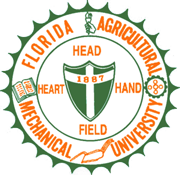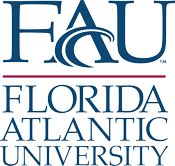News
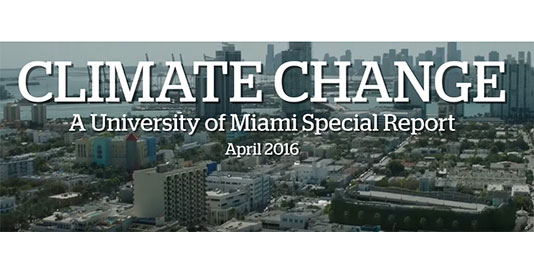 April 20, 2016 - The University of Miami's University Communications has released a Climate Change Special Report showcasing the work of the University's scientists, researchers, faculty, staff, students and alumni in the areas of climate change and sustainability.
April 20, 2016 - The University of Miami's University Communications has released a Climate Change Special Report showcasing the work of the University's scientists, researchers, faculty, staff, students and alumni in the areas of climate change and sustainability.
For nearly six months, a team of writers, editors, videographers, photographers, and web developers and designers worked on this report, which encompasses more than 40 articles, photo galleries, videos, and interactive polls and social engagement.
This report looks at the areas of ocean and atmospheric research, renewable energy options, sustainable design and infrastructure, the spread of vector-borne diseases and health concerns, and population migration impacted by the changing environment, among other topics of interest.
Dozens of sources were interviewed for this report, which quotes or mentions more than 70 faculty, students, alumni and staff, and touches all the University's 11 schools and colleges.
April 25, 2016 - With a $5,000,000 grant from the National Science Foundation, Florida International University will establish the Center for Aquatic Chemistry and the Environment (CREST). The 5-year project will be led by Todd A. Crowl. Additional researchers are Rudolf Jaffe, Rene M. Price, Shu-Ching Chen, Laird H. Kramer.
Human-derived environmental contaminants consist of antibiotics and pharmaceuticals, mercury, black carbon, and fossil fuels. These stressors are recognized as having significant effects on ecosystems and biota as well as on human wellbeing. It is critical to understand the biogeochemical processes that govern the fate of these compounds and their impacts on the ecosystem. Center for Aquatic Chemistry and the Environment research will address the sources, transport, transformation and ecosystem responses to contaminants, pollutants and other natural stressors, under changing land-use and environmental conditions.
The Center for Aquatic Chemistry and the Environment will generate significant new knowledge regarding contaminants and pollutants in aquatic environments, as well as produce innovative methodologies for detecting and assessing contaminant quantities and impacts, including the use of molecular detection techniques. The proposed research will advance current efforts on the biological effects, transport, transformation and distribution of contaminants in the environment into new collaborative research areas that investigate the sources and transport of contaminants and pollutants in aquatic systems.
The Center articulates three research subprojects organized around environmental chemistry, biogeochemistry, ecology and data synthesis and modeling as they pertain to regional water resources. The first subproject will advance the effectiveness of approaches for the analysis of traditional pollutants, develop methodologies for the characterization and quantification of previously unknown contaminants and extend the applicability of molecular biology methodologies to assess environmental stressors to aquatic organisms across land-use boundaries. The second subproject uses new sensing techniques to determine biogeochemical cycles including contaminant sources, storage, transport and transformations. The third research subproject develops data analytic methods to enable synthesis across large, complex data sets to allow holistic effects assessment for understanding South Florida's aquatic ecosystem.
The Center for Aquatic Chemistry and the Environment will establish innovative opportunities for students to experience authentic and socially relevant environmental research and foster their development as future STEM professionals.
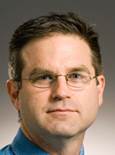 May 2, 2016 - In May 2016, Professor Greg Kiker, Department of Agricultural & Biological Engineering at UF, will visit the University of Oxford Environmental Change Institute (Oxford-ECI) and its research partners, as the first FCI UF-UK fellow, to establish a framework to integrate models from Oxford-ECI and UF into more localized household-scale models for analysis in six countries in Africa and Southeast Asia. This collaboration will help UF, Oxford and the International Livestock and Research Institute (ILRI) to focus research and outreach towards sustainable livestock systems. Dr. Kiker will work with Drs. John Ingram, Steven Lord, Joost Vervoort and Ariella Helfgott (Oxford-ECI) to translate recently developed climate change scenarios and household vulnerability research into both conceptual frameworks and computational models for west and east Africa. This effort is part of the newly established Feed the Future Innovation Lab for Livestock Systems at UF to focus research and outreach towards sustainable livestock systems.
May 2, 2016 - In May 2016, Professor Greg Kiker, Department of Agricultural & Biological Engineering at UF, will visit the University of Oxford Environmental Change Institute (Oxford-ECI) and its research partners, as the first FCI UF-UK fellow, to establish a framework to integrate models from Oxford-ECI and UF into more localized household-scale models for analysis in six countries in Africa and Southeast Asia. This collaboration will help UF, Oxford and the International Livestock and Research Institute (ILRI) to focus research and outreach towards sustainable livestock systems. Dr. Kiker will work with Drs. John Ingram, Steven Lord, Joost Vervoort and Ariella Helfgott (Oxford-ECI) to translate recently developed climate change scenarios and household vulnerability research into both conceptual frameworks and computational models for west and east Africa. This effort is part of the newly established Feed the Future Innovation Lab for Livestock Systems at UF to focus research and outreach towards sustainable livestock systems.
Food systems exist in an increasingly unpredictable and inequitable world as climate drivers and market dynamics do not often align for the benefit of local livelihoods. Livestock sectors also share this challenge as increasing international demand for livestock products does not translate to increased growth opportunities at the household level.
For more information on the program, click here.
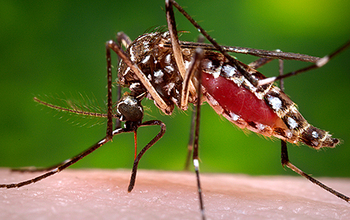 May 12, 2016 - Dr. Sadie Ryan (Assistant Professor of Medical Geography in the Department of Geography and UF’s Emerging Pathogen Institute) and colleagues, have just received a National Science Foundation (NSF) Division of Environmental Biology’s Ecology and Evolution of Infectious Diseases (EEID) Program rapid response, or RAPID grant to study the socio-ecology and climate responses of Zika virus transmission by Aedes aegypti mosquitoes in southern coastal Ecuador. By analyzing blood samples, deploying climate sensors, and conducting socio-ecological surveys, the researchers will gain insight into the spread of Zika as climate, altitude and socioeconomic levels change.
May 12, 2016 - Dr. Sadie Ryan (Assistant Professor of Medical Geography in the Department of Geography and UF’s Emerging Pathogen Institute) and colleagues, have just received a National Science Foundation (NSF) Division of Environmental Biology’s Ecology and Evolution of Infectious Diseases (EEID) Program rapid response, or RAPID grant to study the socio-ecology and climate responses of Zika virus transmission by Aedes aegypti mosquitoes in southern coastal Ecuador. By analyzing blood samples, deploying climate sensors, and conducting socio-ecological surveys, the researchers will gain insight into the spread of Zika as climate, altitude and socioeconomic levels change.
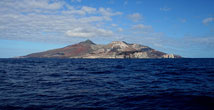 May 24, 2016 (Source: UM RSMAS) - Paquita Zuidema, a scientist at the University of Miami (UM) Rosenstiel School of Marine and Atmospheric Science, is leading an upcoming international research campaign to study a significant contributor to regional climate warming - smoke. The first-of-its-kind research experiment begins on June 1, 2016 from Ascension Island in the southeastern Atlantic Ocean. The experiment, called LASIC (Layered Atlantic Smoke Interactions with Clouds), is part of a broader international scientific collaboration led by the Atmospheric Radiation Measurement (ARM) Climate Research Facility deployment. The broad collaboration is detailed in a new article in the July Bulletin of the American Meteorological Society.
May 24, 2016 (Source: UM RSMAS) - Paquita Zuidema, a scientist at the University of Miami (UM) Rosenstiel School of Marine and Atmospheric Science, is leading an upcoming international research campaign to study a significant contributor to regional climate warming - smoke. The first-of-its-kind research experiment begins on June 1, 2016 from Ascension Island in the southeastern Atlantic Ocean. The experiment, called LASIC (Layered Atlantic Smoke Interactions with Clouds), is part of a broader international scientific collaboration led by the Atmospheric Radiation Measurement (ARM) Climate Research Facility deployment. The broad collaboration is detailed in a new article in the July Bulletin of the American Meteorological Society.
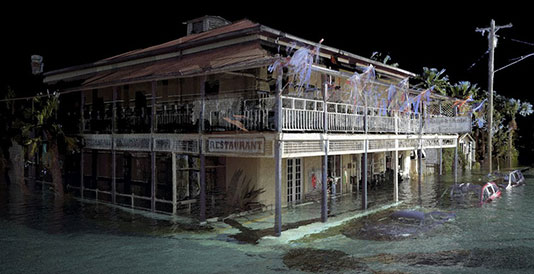 June 1, 2016 - The Summer 2016 issue of the University of Florida's Explore magazine is now out and features the Florida Climate Institute at UF Director, co-Director, and several affiliated faculty. See http://explore.research.ufl.edu/ for the online version of several of the stories that the magazine features. The climate-themed issue includes stories on sea-level rise, coastal planning, agriculture, energy efficiency, economics, design, health, coastal forestry, and humanities.
June 1, 2016 - The Summer 2016 issue of the University of Florida's Explore magazine is now out and features the Florida Climate Institute at UF Director, co-Director, and several affiliated faculty. See http://explore.research.ufl.edu/ for the online version of several of the stories that the magazine features. The climate-themed issue includes stories on sea-level rise, coastal planning, agriculture, energy efficiency, economics, design, health, coastal forestry, and humanities.
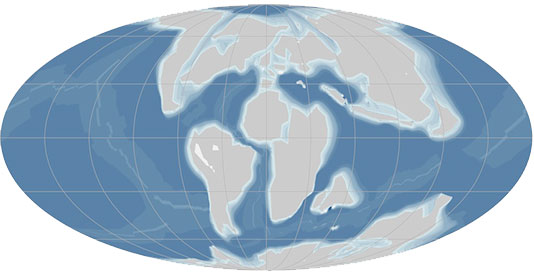 June 22, 2016 - A major climate event millions of years ago that caused substantial change to the ocean’s ecological systems may hold clues as to how the Earth will respond to future climate change, a Florida State University researcher said.
June 22, 2016 - A major climate event millions of years ago that caused substantial change to the ocean’s ecological systems may hold clues as to how the Earth will respond to future climate change, a Florida State University researcher said.
In a new study published in Earth and Planetary Science Letters, Assistant Professor of Geology Jeremy Owens explains that parts of the ocean became inhospitable for some organisms as the Earth’s climate warmed 94 million years ago. As the Earth warmed, several natural elements — what we think of as vitamins — depleted, causing some organisms to die off or greatly decrease in numbers.
The elements that faded away were vanadium and molybdenum, important trace metals that serve as nutrients for ocean life. Molybdenum in particular is used by bacteria to help promote nitrogen fixation, which is essential for all forms of life.
“These trace metals were drawn down to levels below where primary producing organisms, the base of the ocean food chain, can survive,” Owens said. “This change inhibited biology.”
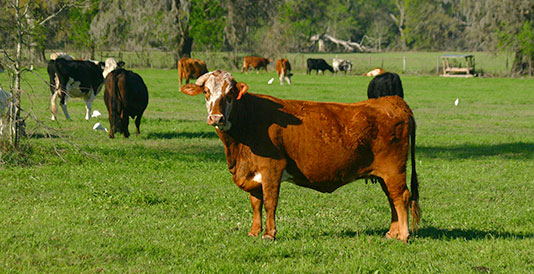 June 22, 2016 - University of Florida Institute of Food and Agricultural Sciences researchers hope to reduce possible pollutants emanating from soils in Florida cattle ranches by using a $710,000 USDA grant to study soil microbes.
June 22, 2016 - University of Florida Institute of Food and Agricultural Sciences researchers hope to reduce possible pollutants emanating from soils in Florida cattle ranches by using a $710,000 USDA grant to study soil microbes.
In the new study, UF/IFAS researchers will use lab and field studies to investigate how pasture management and factors such as temperature and rainfall affect soil microbes. They’ll also look for genetic markers to get a glimpse into microbial identity. Genetic markers are genes or short sequences of DNA scientists use to find other genes on a genetic map.
“The goal is to put together a model that can predict the release of greenhouse gases like carbon dioxide and nitrous oxide from soils under a climate that is expected to be warmer and experience more extreme dry and wet periods across the Southeast,” said Stefan Gerber, a UF/IFAS assistant professor in soil and water sciences and one of the investigators on the new study.
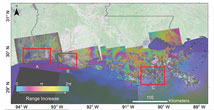 June 28, 2016 (Source: UM RSMAS) - As Louisiana’s wetlands continue to disappear at an alarming rate, a new study has pinpointed the man-made structures that disrupt the natural water flow and threaten these important ecosystems. The findings have important implications for New Orleans and other coastal cities that rely on coastal wetlands to serve as buffer from destructive extreme weather events. Scientists at the University of Miami (UM) Rosenstiel School of Marine and Atmospheric Science found that man-made canals limit the natural tidal inundation process in roughly 45 percent of the state’s coastline, and disruptions from levees accounted for 15 percent. “This study demonstrates that human infrastructure development along coastal areas have long-term consequences on the ability of coastal wetlands to adapt to sea-level rise and other processes that reduce the size of coastal wetlands,” said Talib Oliver-Cabrera, the study’s first author and a UM Rosenstiel School Ph.D. student.
June 28, 2016 (Source: UM RSMAS) - As Louisiana’s wetlands continue to disappear at an alarming rate, a new study has pinpointed the man-made structures that disrupt the natural water flow and threaten these important ecosystems. The findings have important implications for New Orleans and other coastal cities that rely on coastal wetlands to serve as buffer from destructive extreme weather events. Scientists at the University of Miami (UM) Rosenstiel School of Marine and Atmospheric Science found that man-made canals limit the natural tidal inundation process in roughly 45 percent of the state’s coastline, and disruptions from levees accounted for 15 percent. “This study demonstrates that human infrastructure development along coastal areas have long-term consequences on the ability of coastal wetlands to adapt to sea-level rise and other processes that reduce the size of coastal wetlands,” said Talib Oliver-Cabrera, the study’s first author and a UM Rosenstiel School Ph.D. student.
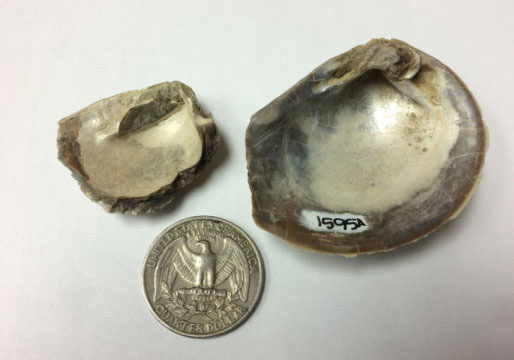 July 5, 2016 - A new reconstruction of Antarctic ocean temperatures around the time the dinosaurs disappeared 66 million years ago supports the idea that one of the planet's biggest mass extinctions was due to the combined effects of volcanic eruptions and an asteroid impact.
July 5, 2016 - A new reconstruction of Antarctic ocean temperatures around the time the dinosaurs disappeared 66 million years ago supports the idea that one of the planet's biggest mass extinctions was due to the combined effects of volcanic eruptions and an asteroid impact.
Two University of Michigan researchers and University of Florida colleague Andrea Dutton found two abrupt warming spikes in ocean temperatures that coincide with two previously documented extinction pulses near the end of the Cretaceous Period. The first extinction pulse has been tied to massive volcanic eruptions in India, the second to the impact of an asteroid or comet on Mexico's Yucatan Peninsula.
Both events were accompanied by warming episodes the team found by analyzing the chemical composition of fossil shells using a recently developed technique called the carbonate clumped isotope paleothermometer.
Nature Communications Journal Article
University of Michigan News Release
Image caption: The preservation of Cretaceous mollusk fossils from Seymour Island is excellent, with shells preserving original mother-of-pearl material as in these two specimens of Eselaevitrigonia regina. Image credit: Sierra V. Petersen
 July 7, 2016 (Source: UM RSMAS) - Scientists at the University of Miami (UM) Rosenstiel School of Marine and Atmospheric Science are taking advantage of this year’s dust season to study the aging of these aerosol particles that travel across the Atlantic Ocean from Africa to Florida. The study will take place from 1 July to 31 August and will help improve weather and climate forecasts, including our understanding of the early development of tropical storms.
July 7, 2016 (Source: UM RSMAS) - Scientists at the University of Miami (UM) Rosenstiel School of Marine and Atmospheric Science are taking advantage of this year’s dust season to study the aging of these aerosol particles that travel across the Atlantic Ocean from Africa to Florida. The study will take place from 1 July to 31 August and will help improve weather and climate forecasts, including our understanding of the early development of tropical storms.
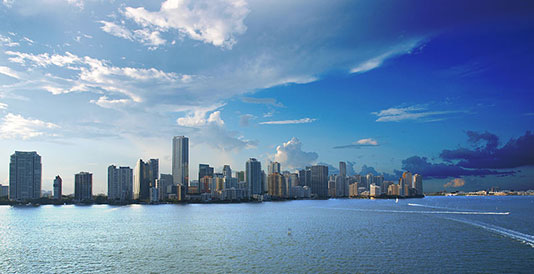 July 11, 2016 - The Florida Institute for Health Innovation (FIHI), in conjunction with the South Florida Regional Planning Council and Florida Atlantic University’s Center for Environmental Studies, mapped zones most prone to environmental sea level rise impacts, described associated public health risks and identified the region’s socially, economically and medically vulnerable communities most susceptible to sea level rise health effects.
July 11, 2016 - The Florida Institute for Health Innovation (FIHI), in conjunction with the South Florida Regional Planning Council and Florida Atlantic University’s Center for Environmental Studies, mapped zones most prone to environmental sea level rise impacts, described associated public health risks and identified the region’s socially, economically and medically vulnerable communities most susceptible to sea level rise health effects.
For the study, FIHI developed an innovative public health framework that links socio-economic vulnerability and health risks to climate change effects.
A result of two years of cross-sector research and outreach, the FIHI final report entitled Health and Sea-level rise: Impacts on South Florida includes a detailed discussion of the study’s multiple methodologies as well as a toolkit that can be used to inform adaptation, mitigation and infrastructure planning.
 July 27, 2016 - The International Commission on Statistical Hydrology of the International Association of Hydrological Sciences (ICSH-IAHS) is awarding the 2016 Statistics in Hydrology (STAHY) Best Paper Award to Jose D. Salas of Colorado State University and Jayantha Obeysekera of the South Florida Water Management District for the following research paper:
July 27, 2016 - The International Commission on Statistical Hydrology of the International Association of Hydrological Sciences (ICSH-IAHS) is awarding the 2016 Statistics in Hydrology (STAHY) Best Paper Award to Jose D. Salas of Colorado State University and Jayantha Obeysekera of the South Florida Water Management District for the following research paper:
Salas, J. D., & Obeysekera, J. (2014). Revisiting the Concepts of Return Period and Risk for Nonstationary Hydrologic Extreme Events. J. Hydrol. Eng., 19(3), 554–568.
This is a new IAHS prize, recently introduced by the ICSH-IAHS Commission, that awards the most promising work in Statistical Hydrology among a large number of papers published in hydrological journals. The STAHY Best Paper Award 2016 will be assigned during the STAHY'16 Conference in Quebec City, September 2016.
July 27, 2016 - The National Oceanic and Atmospheric Administration (NOAA) has awarded $380,476 for a project led by researchers at FSU and NOAA/AOML titled, "Development of New Drifter Technology for Observing Currents at the Ocean Surface." Drs. Steve Morey, Nico Wienders, Mark Bourassa, and Dmitry Dukhovskoy (all of FSU), as well as Dr. Rick Lumpkin (NOAA/AOML), will develop and test a new satellite tracked drifter design for measuring currents at the very surface of the ocean. Typically, observations of "surface" currents really measure the current over the upper several meters, but these currents may be substantially different than the currents right at the surface. Through field experiments with these drifters together with more traditional upper ocean current observation methods, the researchers will gain a better understanding of the vertical structure of currents near the ocean surface. This work will benefit pollutant and debris tracking, air-sea flux measurements and modeling, and provide a tool for validating surface current measurements from future remote sensing instruments. The new drifter technology is anticipated to become available for widespread use and commercialization.
 July 27, 2016 - Dr. Andrea Dutton (University of Florida) has been elected a Fellow of the Geological Society of America (GSA). GSA members are nominated by existing GSA Fellows in recognition of their distinguished contributions to the geosciences through such avenues as publications, applied research, teaching, administration of geological programs, contributing to the public awareness of geology, leadership of professional organizations, and taking on editorial, bibliographic, and library responsibilities.
July 27, 2016 - Dr. Andrea Dutton (University of Florida) has been elected a Fellow of the Geological Society of America (GSA). GSA members are nominated by existing GSA Fellows in recognition of their distinguished contributions to the geosciences through such avenues as publications, applied research, teaching, administration of geological programs, contributing to the public awareness of geology, leadership of professional organizations, and taking on editorial, bibliographic, and library responsibilities.
Nominator Benjamin Horton (Rutgers University) said of Dr. Dutton: "Andrea displays enthusiasm and energy, as well as an encyclopedic knowledge of geology. She quotes the primary geoscience literature at will both historic as well as modern. This plus her creativity to isolate the basic mechanisms of sea level change is a rare and unbeatable combination."
 July 28, 2016 (Source: UM RSMAS) - A new study by an international team of scientists reveals the exact timing of the onset of the modern monsoon pattern in the Maldives 12.9 million years ago, and its connection to past climate changes and coral reefs in the region. The analysis of sediment cores provides direct physical evidence of the environmental conditions that sparked the monsoon conditions that exist today around the low-lying island nation and the Indian subcontinent.
July 28, 2016 (Source: UM RSMAS) - A new study by an international team of scientists reveals the exact timing of the onset of the modern monsoon pattern in the Maldives 12.9 million years ago, and its connection to past climate changes and coral reefs in the region. The analysis of sediment cores provides direct physical evidence of the environmental conditions that sparked the monsoon conditions that exist today around the low-lying island nation and the Indian subcontinent.
In Nov. 2015, University of Miami (UM) Rosenstiel School of Marine and Atmospheric Science geoscientist Gregor Eberli, along with his co-chief scientist Christian Betzler and an international team of 31 scientists from 15 countries, embarked on an eight-week expedition to the Maldives aboard the research vesselJOIDES Resolution. The scientific team on International Ocean Discovery Program (IODP) Expedition 359, which included UM geochemist Peter Swart and sedimentologist Anna Ling, extracted 3,097 meters of sediment cores that contain the history of the monsoon that is the most intense annually recurring climatic element on Earth. The monsoon system supplies moisture to the Indian subcontinent, which is important for the human population and vegetation in the region, as well as marine ecosystem in the surrounding seas.
August 1, 2016 - Dr. Lydia Stefanova (FSU) will be collaborating with biologists from the USGS Wetland and Aquatic Research Center on a project entitled "Developing Weather and Climate-Based Environmental Indices for a Common Framework to Model Survival, Reproductive and Movement Rates of Sea Turtles, Gulf Sturgeon and Manatees in the Northern Gulf of Mexico (GoM)."
The research was funded by USGS to identify specific measures (indices) of climate stressors (extreme cold/heat/drought/flood during key periods of the year) that are pertinent to sea turtles,Gulf sturgeon, and manatees in the northern GoM. These measures in combination with historical data for the species' populations will be used to develop models for their survival, reproduction and movement. Eventually, these models, in combination with climate projections for the climate stressor indices, will be used to make projections for the future species populations under projected climate change.
 August 1, 2016 - A study conducted by a research team including members from University of Florida, Texas A&M University, and Virginia Polytechnic Institute and State University shows that business vulnerability to flooding will be escalated substantially by sea level rise. The findings show that considerable amount of areas, businesses, and road networks would be exposed to highest flood-risk zones due to sea level rise. To quantify the vulnerability of businesses to environmental hazards, the team established a conceptual framework of business vulnerability index incorporating business characteristics, infrastructure factors, and other indicators. A mapped index was displayed in Bay County, Florida.
August 1, 2016 - A study conducted by a research team including members from University of Florida, Texas A&M University, and Virginia Polytechnic Institute and State University shows that business vulnerability to flooding will be escalated substantially by sea level rise. The findings show that considerable amount of areas, businesses, and road networks would be exposed to highest flood-risk zones due to sea level rise. To quantify the vulnerability of businesses to environmental hazards, the team established a conceptual framework of business vulnerability index incorporating business characteristics, infrastructure factors, and other indicators. A mapped index was displayed in Bay County, Florida.
A research paper about this topic has been accepted for publication in the journal Natural Hazards. The paper is titled “Developing a theoretical framework for integrated vulnerability of businesses to sea level rise” and co-authored by Jie Song, Zhong-Ren Peng, Liyuan Zhao, and Chih-Hung Hsu.
Image caption: Composite Business Vulnerability Index in Bay County, Florida.
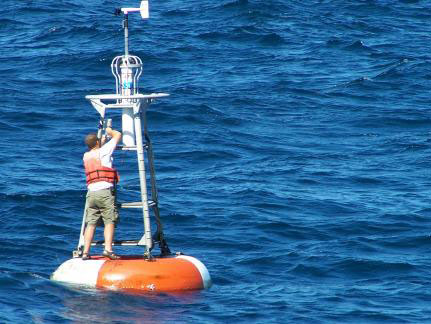 August 1, 2016 - With its latest update, NOAA's International Comprehensive Ocean–Atmosphere Data Set Release 3.0 (ICOADS R3.0) now incorporates a wide range of new and improved data and metadata sources. This new release also fosters closer integration with the oceanographic community by extending ICOADS observations to include near-surface variables—like salinity, nutrients, and dissolved carbonate chemistry—for the first time.
August 1, 2016 - With its latest update, NOAA's International Comprehensive Ocean–Atmosphere Data Set Release 3.0 (ICOADS R3.0) now incorporates a wide range of new and improved data and metadata sources. This new release also fosters closer integration with the oceanographic community by extending ICOADS observations to include near-surface variables—like salinity, nutrients, and dissolved carbonate chemistry—for the first time.
The Marine Data Center at FSU's Center for Ocean-Atmopsheric Prediction Studies has contributed to ICOADS R3.0. A manuscript (ICOADS Release 3.0: a major update to the historical marine climate record) detailing the new release and the contributions by the MDC (particularly providing a subset of high-quality research vessel observations from the SAMOS initiative) was just published in early view by the International Journal of Climatology. Mr. Shawn Smith, the Marine Data Center director, is a co-author on this manuscript and is the lead author of the full ICOADS release 3.0 documentation. Jocelyn Elya, MDC lead programmer, developed the software to support submitting SAMOS data into this release of ICOADS.
ICOADS is the world’s most extensive surface marine meteorological and oceanographic data collection. Building on extensive national and international partnerships, ICOADS provides users with easy access to many different data sources in a consistent format. Data sources range from early non-instrumental ship observations to more recent measurements from automatic systems, such as moored buoys and surface drifters.
ICOADS supports a variety of climate products including the global surface temperature record, winds, pressure, humidity, clouds, and estimates of air–sea exchange. We also use it to develop many other well-used sources of marine climate information, including reanalyses and gridded analyses of sea surface temperature.
August 3, 2016 - A new podcast is now available focusing on climate change adaptation. Learn how America is adapting to this challenge through informative and lively discussions with a mix of adaptation experts. Listen in as Doug Parsons talks to the scientists, planners, NGOs, and elected officials who have something to say about adapting to climate change. The podcast can be downloaded at America Adapts web site via iTunes, Google Play and more.
In Episode #4, Doug Parsons talks with Bob Glazer, research scientist with the Florida Fish and Wildlife Conservation Commission, about how Florida is adapting to climate change.
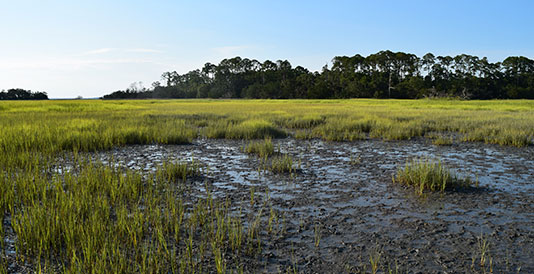 August 19, 2016 - Coastal ecosystems worldwide are feeling the heat of climate change. In the Southeastern U.S., salt marshes have endured massive grass die-offs as a result of intense drought, which can affect everything from fisheries to water quality. Now, new research shows that a mutualistic relationship -- where two organisms benefit from each other's activities -- between ribbed mussels and salt marsh grasses may play a critical role in helping salt marshes bounce back from extreme climate events such as drought.
August 19, 2016 - Coastal ecosystems worldwide are feeling the heat of climate change. In the Southeastern U.S., salt marshes have endured massive grass die-offs as a result of intense drought, which can affect everything from fisheries to water quality. Now, new research shows that a mutualistic relationship -- where two organisms benefit from each other's activities -- between ribbed mussels and salt marsh grasses may play a critical role in helping salt marshes bounce back from extreme climate events such as drought.
The results, reported this week in the journal Nature Communications, found that mussels piled up in mounds around salt grass stems helped to protect the grasses by improving water storage around their roots and reducing soil salinity. With the mussels' help, marshes can recover from drought in less than a decade. Without their help, it can take more than a century.
"This is a very good example of how the diversity of life in a salt marsh promotes resilience to climate and environmental change," said David Garrison, program director in the National Science Foundation (NSF) Division of Ocean Sciences, which co-funded the research with NSF's Division of Environmental Biology.
"It's a story of mutual benefit between marsh grass and mussels," said Christine Angelini, a scientist at the University of Florida and lead author of the paper. The mussels, she said, "protect then accelerate the healing of drought-stricken marshes."
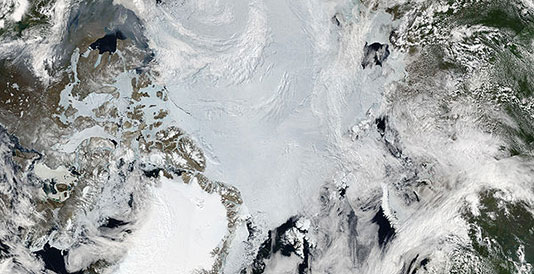 August 22, 2016 - A University of Alaska Fairbanks-led research project co-authored by Dr. Jeff Chanton (FSU) has provided the first modern evidence of a landscape-level permafrost carbon feedback, in which thawing permafrost releases ancient carbon as climate-warming greenhouse gases.
August 22, 2016 - A University of Alaska Fairbanks-led research project co-authored by Dr. Jeff Chanton (FSU) has provided the first modern evidence of a landscape-level permafrost carbon feedback, in which thawing permafrost releases ancient carbon as climate-warming greenhouse gases.
The project, led by UAF researcher Katey Walter Anthony, studied lakes in Alaska, Canada, Sweden and Siberia where permafrost thaw surrounding lakes led to lake shoreline expansion during the past 60 years. Using historical aerial photo analysis, soil and methane sampling, and radiocarbon dating, the project quantified for the first time the strength of the present-day permafrost carbon feedback to climate warming. Although a large permafrost carbon emission is expected to occur imminently, the results of this study show nearly no sign that it has begun.
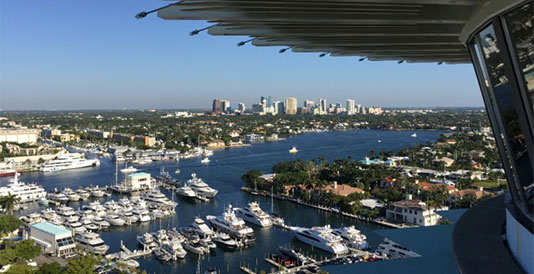 August 25, 2016 - The insights generated by FAU’s Arctic-Florida Sea-Level Rise Summit in May 2016 mark an important stage in the process of community engagement on sea-level rise and coastal erosion. “Adaptation Pathways 1.0” summarizes the 3rd Sea-Level Rise Summit organized by the Florida Center for Environmental Studies at Florida Atlantic University. The event, subtitled “Connected Futures from Alaska to Florida,” was held May 3-5, 2016, at the Ft. Lauderdale Hyatt Pier 66. In recent years, many conferences and meetings have identified the problems we face, and outlined some theoretical solutions. What we lacked was guidance for implementing specific adaptations. The goal of the Summit was to produce a first-generation roadmap for adaptation, by translating our knowledge and ideas into action. Our resulting Adaptation Pathways (see Section III of this report) have emerged as the product of intense and sustained interactions with Summit participants, representing a broad cross-section of society.
August 25, 2016 - The insights generated by FAU’s Arctic-Florida Sea-Level Rise Summit in May 2016 mark an important stage in the process of community engagement on sea-level rise and coastal erosion. “Adaptation Pathways 1.0” summarizes the 3rd Sea-Level Rise Summit organized by the Florida Center for Environmental Studies at Florida Atlantic University. The event, subtitled “Connected Futures from Alaska to Florida,” was held May 3-5, 2016, at the Ft. Lauderdale Hyatt Pier 66. In recent years, many conferences and meetings have identified the problems we face, and outlined some theoretical solutions. What we lacked was guidance for implementing specific adaptations. The goal of the Summit was to produce a first-generation roadmap for adaptation, by translating our knowledge and ideas into action. Our resulting Adaptation Pathways (see Section III of this report) have emerged as the product of intense and sustained interactions with Summit participants, representing a broad cross-section of society.
 September 12, 2016 (Source: UF/IFAS) - Researchers with the University of Florida Institute of Food and Agricultural Sciences are closer to helping producers better meet global food demand, now that they’ve combined simulation and statistical methods to help them predict how temperature affects wheat crops worldwide. A global team of scientists, led by those at UF/IFAS, used two different simulation methods and one statistical method to predict the impact of rising temperatures on global wheat production, and all came to similar estimates. This finding, published in a study in the journal Nature Climate Change, is critical in predicting how much wheat and other crops we’ll need to feed the world, said Senthold Asseng, a UF/IFAS professor of agricultural and biological engineering and leader of this study.
September 12, 2016 (Source: UF/IFAS) - Researchers with the University of Florida Institute of Food and Agricultural Sciences are closer to helping producers better meet global food demand, now that they’ve combined simulation and statistical methods to help them predict how temperature affects wheat crops worldwide. A global team of scientists, led by those at UF/IFAS, used two different simulation methods and one statistical method to predict the impact of rising temperatures on global wheat production, and all came to similar estimates. This finding, published in a study in the journal Nature Climate Change, is critical in predicting how much wheat and other crops we’ll need to feed the world, said Senthold Asseng, a UF/IFAS professor of agricultural and biological engineering and leader of this study.
September 21, 2016 - Miami-Dade County has released a final status report in response to multiple resolutions pertaining to recommendations by the Miami-Dade Sea Level Rise Task Force.
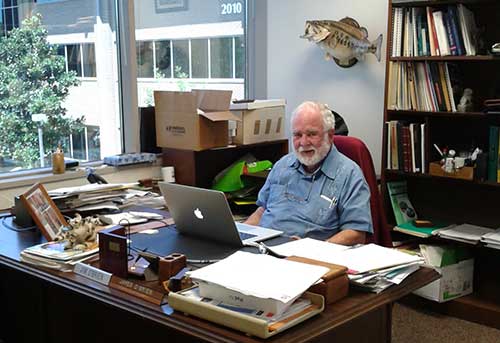 September 22, 2016 - We are tremendously saddened to inform the Florida Climate Institute community that Dr. James O'Brien, Professor Emeritus of Meteorology and Physical Oceanography at Florida State University and the founder of FSU's Center for Ocean-Atmospheric Prediction Studies (COAPS), passed away on September 20. Dr. O'Brien was a founding member of the Board of Directors of the Florida Climate Institute and a founding leader of the Southeast Climate Consortium. He served as State Climatologist of Florida at the Florida Climate Center from 1999 to 2006. Our memory of him remains as someone who was exuberant, approachable, and deeply committed to the mentorship of young scholars.
September 22, 2016 - We are tremendously saddened to inform the Florida Climate Institute community that Dr. James O'Brien, Professor Emeritus of Meteorology and Physical Oceanography at Florida State University and the founder of FSU's Center for Ocean-Atmospheric Prediction Studies (COAPS), passed away on September 20. Dr. O'Brien was a founding member of the Board of Directors of the Florida Climate Institute and a founding leader of the Southeast Climate Consortium. He served as State Climatologist of Florida at the Florida Climate Center from 1999 to 2006. Our memory of him remains as someone who was exuberant, approachable, and deeply committed to the mentorship of young scholars.
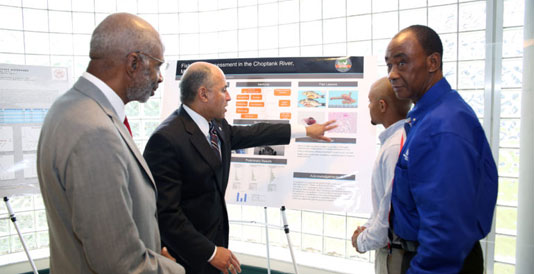 September 26, 2016 (Source: FAMU) - Today, Florida A&M University (FAMU) announced the receipt of a $15.4 million award over five years from the National Oceanic and Atmospheric Administration (NOAA) Educational Partnership Program (EPP) to establish the Center for Coastal and Marine Ecosystems (CCME). The new award will allow the FAMU-led partnership to make profound national impacts on coastal and marine ecosystems education, science, and policy.
September 26, 2016 (Source: FAMU) - Today, Florida A&M University (FAMU) announced the receipt of a $15.4 million award over five years from the National Oceanic and Atmospheric Administration (NOAA) Educational Partnership Program (EPP) to establish the Center for Coastal and Marine Ecosystems (CCME). The new award will allow the FAMU-led partnership to make profound national impacts on coastal and marine ecosystems education, science, and policy.
FAMU Distinguished Professor Larry Robinson, Ph.D., will serve as the CCME director and principal investigator. The interdisciplinary team at FAMU will include faculty and students from the College of Education, College of Science and Technology, College of Social Sciences, Arts, and Humanities, School of Business and Industry, and School of the Environment.
 October 24, 2016 (Source: FAU/CES) - King Tide brought sunny day flooding to homes and businesses in South Florida this year, and communities want solutions. US Congressman Ted Deutch partnered with Dr. Colin Polsky, director of Florida Center for Environmental Studies at Florida Atlantic University, to bring awareness to the issue. Along with City of Fort Lauderdale commissioners, the Congressman received a briefing on impacts and adaptation strategies from private sector partners First Green Bank, Olive & Judd, and Florida Luxurious Properties, as well as the US Geological Survey, Broward County, Mitigat.com, Hollywood Lakes Civic Association, and Florida Atlantic University. The media were paying attention. Local CBS and ABC television stations covered the story, as did Sun Sentinel. “If standing in this water on a beautiful South Florida morning doesn’t tell us that it’s time we start investing in environmental infrastructure to protect our communities, then I don’t think anything will,” said Deutch. - NPR affiliate WLRN
October 24, 2016 (Source: FAU/CES) - King Tide brought sunny day flooding to homes and businesses in South Florida this year, and communities want solutions. US Congressman Ted Deutch partnered with Dr. Colin Polsky, director of Florida Center for Environmental Studies at Florida Atlantic University, to bring awareness to the issue. Along with City of Fort Lauderdale commissioners, the Congressman received a briefing on impacts and adaptation strategies from private sector partners First Green Bank, Olive & Judd, and Florida Luxurious Properties, as well as the US Geological Survey, Broward County, Mitigat.com, Hollywood Lakes Civic Association, and Florida Atlantic University. The media were paying attention. Local CBS and ABC television stations covered the story, as did Sun Sentinel. “If standing in this water on a beautiful South Florida morning doesn’t tell us that it’s time we start investing in environmental infrastructure to protect our communities, then I don’t think anything will,” said Deutch. - NPR affiliate WLRN
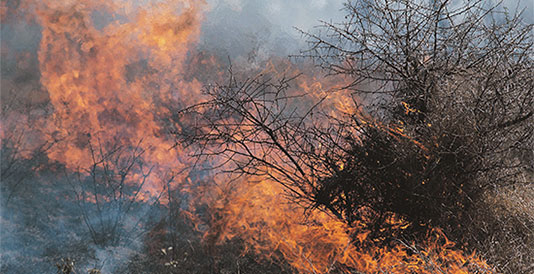 October 28, 2016 - A team led by FSU assistant professor of geography Chris Uejio and state climatologist David Zierden has received a $1.07 million grant from the Centers for Disease Control and Prevention to help county health departments across Florida adapt to problems created by changing environmental factors such as climate change. The team will work with individual Florida counties to assess potential environmental problems that would affect public health. They will also help health officials develop action plans to combat these issues. Other members of the FL BRACE team from Florida State include This email address is being protected from spambots. You need JavaScript enabled to view it. and Danny Brouillette from the Center for Ocean and Atmospheric Studies, and assistant professor of urban and regional planning Tisha Holmes.
October 28, 2016 - A team led by FSU assistant professor of geography Chris Uejio and state climatologist David Zierden has received a $1.07 million grant from the Centers for Disease Control and Prevention to help county health departments across Florida adapt to problems created by changing environmental factors such as climate change. The team will work with individual Florida counties to assess potential environmental problems that would affect public health. They will also help health officials develop action plans to combat these issues. Other members of the FL BRACE team from Florida State include This email address is being protected from spambots. You need JavaScript enabled to view it. and Danny Brouillette from the Center for Ocean and Atmospheric Studies, and assistant professor of urban and regional planning Tisha Holmes.
 October 28, 2016 (By Hannah O. Brown, UF/SNRE) - In less than a year, Russell Anderson plans to be working hands-on, surveying coastal planning projects worldwide. Anderson is a second-year master’s student studying sustainable development, and he is one of a number of students who have decided to pursue UF’s Concentration in Climate Science, an interdisciplinary concentration through the School of Natural Resources and Environment and in collaboration with the Florida Climate Institute. “Internationally, everybody is really trying to plan for the population of what will happen by 2050, with 70 percent of people being in low-lying urban areas,” Anderson said. “That’s over 7 billion people, coast-to-coastline, all stuck in urban centers.” Through taking classes within the concentration, Anderson has gained professional skills and insight into climate change issues on a global scale. “It really made sense based on my professional interest long term, and it was also a chance to really get educated about [climate change effects] that we are already starting to see happening in certain areas,” Anderson said.
October 28, 2016 (By Hannah O. Brown, UF/SNRE) - In less than a year, Russell Anderson plans to be working hands-on, surveying coastal planning projects worldwide. Anderson is a second-year master’s student studying sustainable development, and he is one of a number of students who have decided to pursue UF’s Concentration in Climate Science, an interdisciplinary concentration through the School of Natural Resources and Environment and in collaboration with the Florida Climate Institute. “Internationally, everybody is really trying to plan for the population of what will happen by 2050, with 70 percent of people being in low-lying urban areas,” Anderson said. “That’s over 7 billion people, coast-to-coastline, all stuck in urban centers.” Through taking classes within the concentration, Anderson has gained professional skills and insight into climate change issues on a global scale. “It really made sense based on my professional interest long term, and it was also a chance to really get educated about [climate change effects] that we are already starting to see happening in certain areas,” Anderson said.
The idea for the UF Climate Science Concentration was first conceived by faculty who were considering the notion of establishing a certificate program, geared toward professionals. With the basic structure of the concentration already in motion, SNRE Director Tom Frazer suggested FCI and SNRE switch their focus, in the short term, to enhancing the skills of graduate students instead. “I suggested that there was actually a more immediate need to offer those courses to our students rather than the place-based professionals,” Frazer said. “And a concentration, at the time, was a more effective way to start to put a focus on climate in the curriculum.”
The FCI faculty advisory committee, which is made up of professors from biology, geology, SNRE, forestry, Latin American studies and geography, approved the first list of courses for the concentration in the fall of 2014. The concentration is divided into four categories of study: principles of climate science, system-specific climate science, quantitative methods and human dimensions. Students pursuing the concentration are required to take at least one course from each category, for a total of 12 credit hours.
Carolyn Cox, UF coordinator for the Florida Climate Institute, said the human-dimensions component of the program is just as important as the scientific training. “There’s so many people who work in different disciplines who use climate science, and there is always this need for how to talk to people about it,” she said. While it has become increasingly important for researchers to effectively communicate about their findings, Cox believes there is still resistance from many scientists who prefer to focus simply on the science. However, Cox said that the problem with this reluctance is that some of these scientists lack the skillset to see through the tactics that others use to discredit their research. “Even scientists, people that are very pro-climate science and advocate climate science, they still fall into that trap of calling it a debate,” Cox said. “It’s not a debate. A debate is when there are actually two sides to a story. There’s not really two sides here. There’s a manufactured side and a real side.” Cox hopes that the Climate Science Concentration can help teach the skills needed to accurately represent climate-related research even when confronted with skepticism and denial. “People need to know how not to fall into those traps,” she said, “how to stay dignified, not fall into the he-said-she-said garbage and not embarrass themselves.”
For Frazer, it’s particularly important to provide the opportunity for SNRE students to focus on climate science through a concentration, because it gives those students a chance to specialize, making their skills more marketable in the professional world. “There is a real risk in getting an interdisciplinary degree where the emphasis is simply on breadth,” he said, “but one of the ways that you deal with depth and the ability to convince a potential employer, whether it’s in an academic setting, a government setting or some other work-related environment, is that you actually have a focus area.” Frazer said having concentrations is one way for SNRE students to showcase the particular skills they acquire while pursuing their degree. “It provides depth,” he said. “Recognizable, identifiable, demonstrable depth in a subject area that complements the broader interdisciplinary degree.” Future plans for the concentration include the possibility of offering a travel stipend to students who are interested in attending climate-science conferences, workshops and giving presentations. Cox said she is still hoping to expand the program to include a certificate, allowing professionals as well as students to become more aware of the science and better able to communicate it.
 October 31, 2016 - Dr. Andrea Dutton (UF) spoke to an audience of mayors and city innovators at the CityLab 2016 summit in Miami on October 24th about considering the longer term future of their cities when planning for adaptations to sea-level rise. CityLab is a venue for Mayors of cities from around the globe to come together to discuss innovative solutions for cities, sponsored by Bloomberg Philanthropies, The Atlantic, and The Aspen Institute. This year’s events featured mayors from Washington D.C., Detroit, Miami, Mexico City (Mexico), Bogota (Colombia) among others. Sustainability and adaptation in the context of ongoing climate change and sea-level rise were hot topics of discussion during the two-day event. A video of Dr. Dutton's talk can be viewed here: https://youtu.be/wbTzdQuSoHM
October 31, 2016 - Dr. Andrea Dutton (UF) spoke to an audience of mayors and city innovators at the CityLab 2016 summit in Miami on October 24th about considering the longer term future of their cities when planning for adaptations to sea-level rise. CityLab is a venue for Mayors of cities from around the globe to come together to discuss innovative solutions for cities, sponsored by Bloomberg Philanthropies, The Atlantic, and The Aspen Institute. This year’s events featured mayors from Washington D.C., Detroit, Miami, Mexico City (Mexico), Bogota (Colombia) among others. Sustainability and adaptation in the context of ongoing climate change and sea-level rise were hot topics of discussion during the two-day event. A video of Dr. Dutton's talk can be viewed here: https://youtu.be/wbTzdQuSoHM
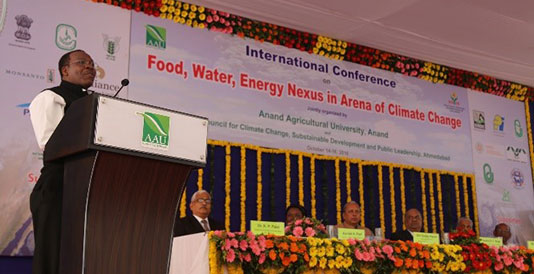 October 31, 2016 - Dr. O.S. Mbuya was recently invited to India as one of the keynote speakers at the International Conference on Food, Water, Energy Nexus in Arena of Climate Change representing Florida A&M University (FAMU) and the Florida Climate Institute (FCI). Prior to the meeting, he visited the State Government of Gujarat where he met with the high ranking State officials, including the Honorable Chief Secretary of Gujarat (Dr. J.N. Singh), the Honorable Minister of Agriculture of Gujarat (Shri Chimanbhai Saparia). Accompanying Dr. Mbuya to the State Government headquarters were the Vice Chancellor of Anand Agricultural University (Dr. N.C. Patel), the Vice Chancellor of Junagadh Agricultural University (Dr. A.R. Pathak) and the Executive Chairman of NCCSD (Dr. Kirit Shelat. Topics discussed under the umbrella of FCI included Climate Change, ClimateSmart Agriculture and International collaborative research.
October 31, 2016 - Dr. O.S. Mbuya was recently invited to India as one of the keynote speakers at the International Conference on Food, Water, Energy Nexus in Arena of Climate Change representing Florida A&M University (FAMU) and the Florida Climate Institute (FCI). Prior to the meeting, he visited the State Government of Gujarat where he met with the high ranking State officials, including the Honorable Chief Secretary of Gujarat (Dr. J.N. Singh), the Honorable Minister of Agriculture of Gujarat (Shri Chimanbhai Saparia). Accompanying Dr. Mbuya to the State Government headquarters were the Vice Chancellor of Anand Agricultural University (Dr. N.C. Patel), the Vice Chancellor of Junagadh Agricultural University (Dr. A.R. Pathak) and the Executive Chairman of NCCSD (Dr. Kirit Shelat. Topics discussed under the umbrella of FCI included Climate Change, ClimateSmart Agriculture and International collaborative research.
The Honorable Minister of Agriculture of the Government of India (Shri Parshottam Rupala) and the Principal Secretary of Ministry of Agriculture of the Government of India (Dr. Sanjay Prasad) attended the International Conference on Food, Water, Energy Nexus in Arena of Climate Change at Anand Agricultural University, and they both echoed the significance of partnership between FAMU/FCI and the Government of India. Currently there are pending MoUs between FAMU and Anand Agricultural University, Junagadh Agricultural University, University of Mumbai and India Council of Agricultural Research (ICAR). ICAR is a federal agency which oversees all 73 agricultural universities in India. The Government of the State of Gujarat and the Government of India are very receptive and supportive of the FAMU and FCI-India Initiative.
Next month, Dr. Mbuya will travel to Marakkesh, Morocco to represent FAMU and FCI at the United Nations Forum for Climate Change Convention (UNFCCC) and COP22. Last year, he presented an FCI poster at the UNFCCC/COP21 in Paris where he highlighted the scientific milestones of FCI. Institutions of the FCI consortium are hereby requested to suggest and/or submit any material they would like to be presented at the COP22 in Morocco.
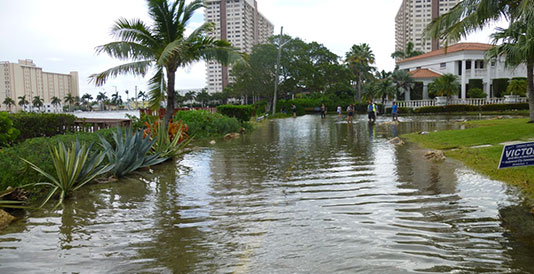 October 31, 2016 - This past month, the Sea Level Solutions Center (SLSC), the Office of University Sustainability and the School of Communication & Journalism at Florida International University teamed up with Eyes on the Rise, the Miami-Dade County Office of Resilience, and the CLEO Institute, to collect data on King tides and flooding in the community. This year’s Sea Level Solutions Day saw a large group of students, teachers, citizens and community leaders coming out to get involved with local flood awareness efforts and citizen science reporting. After meeting at Vizcaya’s Village & Garage to collect their citizen science kits, teams were out measuring flooding at a range of locations around Southeast Florida – from Biscayne Bay to Hollywood – with the majority of reports showing flood levels between 5-12 inches. Their measurements have contributed valuable data to the Eyes On The Rise app, which is helping people to visualize future flooding scenarios under sea level rise. To find out how you can get involved with future flood reporting events and other sea level activities, just email This email address is being protected from spambots. You need JavaScript enabled to view it.!
October 31, 2016 - This past month, the Sea Level Solutions Center (SLSC), the Office of University Sustainability and the School of Communication & Journalism at Florida International University teamed up with Eyes on the Rise, the Miami-Dade County Office of Resilience, and the CLEO Institute, to collect data on King tides and flooding in the community. This year’s Sea Level Solutions Day saw a large group of students, teachers, citizens and community leaders coming out to get involved with local flood awareness efforts and citizen science reporting. After meeting at Vizcaya’s Village & Garage to collect their citizen science kits, teams were out measuring flooding at a range of locations around Southeast Florida – from Biscayne Bay to Hollywood – with the majority of reports showing flood levels between 5-12 inches. Their measurements have contributed valuable data to the Eyes On The Rise app, which is helping people to visualize future flooding scenarios under sea level rise. To find out how you can get involved with future flood reporting events and other sea level activities, just email This email address is being protected from spambots. You need JavaScript enabled to view it.!
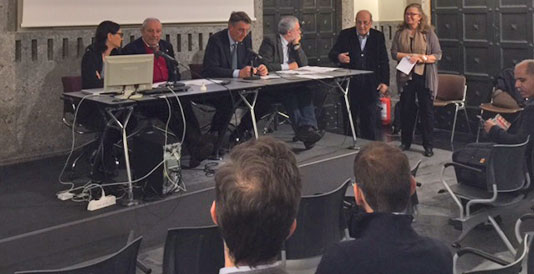 November 1, 2016 - Following the First UNESCO Field Workshop in New York and Miami, and after six months of international coordinated efforts, the organizing parties, The UNESCO CHAIR in Sustainable Urban Quality and Culture, notably in Africa; the Universita’ La Sapienza of Rome, Italy; and the Consortium from Hydro-Generated Urbanism, University of Florida US convened in Rome.
November 1, 2016 - Following the First UNESCO Field Workshop in New York and Miami, and after six months of international coordinated efforts, the organizing parties, The UNESCO CHAIR in Sustainable Urban Quality and Culture, notably in Africa; the Universita’ La Sapienza of Rome, Italy; and the Consortium from Hydro-Generated Urbanism, University of Florida US convened in Rome.
 November 1, 2016 - Dr. Jennifer Jurado presented an invited Keynote Talk at the 2016 China-US Joint Symposium entitled, “International Nexus of Food, Energy, Water and Soil” held in Yixing, Jiangsu Province, China on October 26-29. The title of her Keynote address was “Building Community Resilience through Integrated Natural Resource and Urban Planning in Broward County, Florida” and included the FCI-Compact partnership as an example of how communities and academia are working together. Jennifer is one of the Founding Steering Committee Members of Southeast Florida Climate Compact, directs the Broward County Environmental Planning and Community Resilience Division, and was among 12 people the White House identified as "Champions of Change" for preparing their communities for the consequences of climate change. While at the event in China, Jennifer met with Dr. James Jones, the Director of the Florida Climate Institute, who is now serving a 2-year term as the Engineering Director for NSF’s INFEWS (Food, Energy, Water Nexus) Program.
November 1, 2016 - Dr. Jennifer Jurado presented an invited Keynote Talk at the 2016 China-US Joint Symposium entitled, “International Nexus of Food, Energy, Water and Soil” held in Yixing, Jiangsu Province, China on October 26-29. The title of her Keynote address was “Building Community Resilience through Integrated Natural Resource and Urban Planning in Broward County, Florida” and included the FCI-Compact partnership as an example of how communities and academia are working together. Jennifer is one of the Founding Steering Committee Members of Southeast Florida Climate Compact, directs the Broward County Environmental Planning and Community Resilience Division, and was among 12 people the White House identified as "Champions of Change" for preparing their communities for the consequences of climate change. While at the event in China, Jennifer met with Dr. James Jones, the Director of the Florida Climate Institute, who is now serving a 2-year term as the Engineering Director for NSF’s INFEWS (Food, Energy, Water Nexus) Program.
This symposium was sponsored by the US National Science Foundation and the National Science Foundation of China, and was hosted by Nanjing University. One of the goals of that workshop was to explore ways to increase collaboration between scientists and engineers in China and the USA.
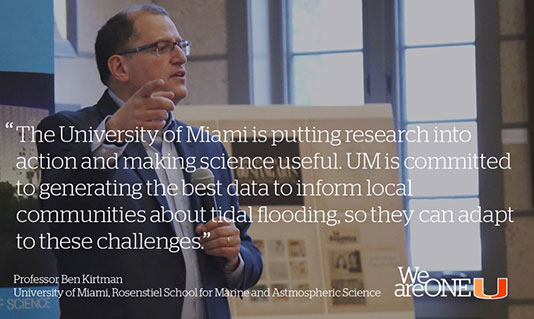 November 2, 2016 (Source: UM/RSMAS) - Severe weather events like Superstorm Sandy are revealing the vulnerability of New York City and other coastal communities, particularly as sea levels continue to rise. In his lab at the University of Miami Rosenstiel School, Ben Kirtman is using one of the world’s largest supercomputers to more accurately predict the risk of severe flooding—in the upcoming weeks and decades. In this ’Cane Talk, Professor Kirtman describes what his research means for cities across the globe.
November 2, 2016 (Source: UM/RSMAS) - Severe weather events like Superstorm Sandy are revealing the vulnerability of New York City and other coastal communities, particularly as sea levels continue to rise. In his lab at the University of Miami Rosenstiel School, Ben Kirtman is using one of the world’s largest supercomputers to more accurately predict the risk of severe flooding—in the upcoming weeks and decades. In this ’Cane Talk, Professor Kirtman describes what his research means for cities across the globe.
Ben Kirtman is a professor of atmospheric sciences at the University of Miami’s Rosenstiel School of Marine and Atmospheric Science. He leads UM’s Cooperative Institute for Marine and Atmospheric Studies and the Center for Computational Science’s Climate and Environmental Hazards Program. Known internationally for using complex computer models to bring unprecedented detail to climate change measurement, Professor Kirtman also serves as an advisor to the United Nations and other multinational organizations.
Click here to watch Ben Kirtman's recent CaneTalk
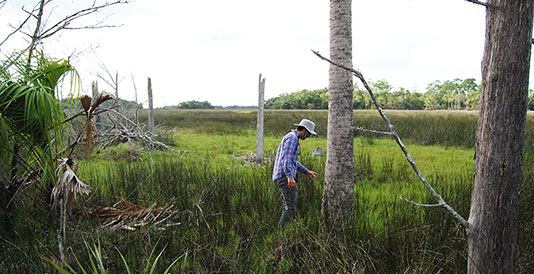 November 2, 2016 (Source: Yale Environment 360) - A steady increase in sea levels is pushing saltwater into U.S. wetlands, killing trees from Florida to as far north as New Jersey. But with sea level projected to rise by as much as six feet this century, the destruction of coastal forests is expected to become a worsening problem worldwide.
November 2, 2016 (Source: Yale Environment 360) - A steady increase in sea levels is pushing saltwater into U.S. wetlands, killing trees from Florida to as far north as New Jersey. But with sea level projected to rise by as much as six feet this century, the destruction of coastal forests is expected to become a worsening problem worldwide.
A new Yale Environment 360 article features research conducted by University of Florida watershed ecologist David Kaplan and Ph.D. candidate Katie Glodzik in the Withlacoochee Gulf Preserve, on the Big Bend coast of northwestern Florida.
Read Full Yale Environment 360 News Article
 November 10, 2016 (Source: UF) - Global climate change has already impacted every aspect of life on Earth, from genes to entire ecosystems, according to a new University of Florida study. The paper appears today in the journal Science.
November 10, 2016 (Source: UF) - Global climate change has already impacted every aspect of life on Earth, from genes to entire ecosystems, according to a new University of Florida study. The paper appears today in the journal Science.
"We now have evidence that, with only a ~1 degree Celsius of warming globally, major impacts are already being felt in natural systems," said study lead author Brett Scheffers, an assistant professor in the department of wildlife, ecology and conservation in UF’s Institute of Food and Agricultural Sciences. "Genes are changing, species’ physiology and physical features such as body size are changing, species are shifting their ranges and we see clear signs of entire ecosystems under stress, all in response to changes in climate on land and in the ocean."
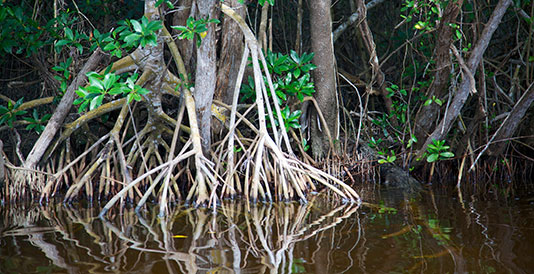 November 14, 2016 (Source: FIU) - When it comes to storing carbon, scientists have put a price tag on the value of mangroves in Everglades National Park and it’s in the billions. Based on a scientific cost estimate, the stored carbon is worth between $2 billion and $3.4 billion, the researchers found. It is a relatively small price when considering the cost to society if the carbon currently stored in these mangroves were ever released into the atmosphere, according to the researchers at FIU who co-authored the study.
November 14, 2016 (Source: FIU) - When it comes to storing carbon, scientists have put a price tag on the value of mangroves in Everglades National Park and it’s in the billions. Based on a scientific cost estimate, the stored carbon is worth between $2 billion and $3.4 billion, the researchers found. It is a relatively small price when considering the cost to society if the carbon currently stored in these mangroves were ever released into the atmosphere, according to the researchers at FIU who co-authored the study.
"Although the Everglades National Park is a protected national treasure, the National Parks Service doesn’t have much control over freshwater flowing into the park," said Mahadev Bhat, co-author of the study and professor in FIU's Department of Earth and Environment. “If there isn’t enough freshwater flowing through the Everglades, we may eventually lose some of the mangroves. And once you let stored carbon out, that same carbon can lead to increased global warming and cost society a lot more.”
In addition to removing excess carbon dioxide from the air, mangroves provide a variety of other benefits, including flood control, storm protection and maintaining water quality. The billion-dollar price tag reflects the cost to preserve the park’s mangroves and their ability to hold organic carbon intact by restoring freshwater flow to the areas that need it the most.
 November 28, 2016 - Dr. Ni-Bin Chang, FCI executive board member and professor at the University of Central Florida, traveled to Brussels, Belgium, this month to receive the Blaise Pascal Medal in Earth and Environmental Sciences from the European Academy of Sciences. The award recognizes Dr. Chang's outstanding contributions to Environmental Sustainability, Green Engineering, and Systems Analysis. Only three scholars worldwide are selected for this award each year. Details may be found at http://www.eurasc.org/medals/pb_medals_16.asp
November 28, 2016 - Dr. Ni-Bin Chang, FCI executive board member and professor at the University of Central Florida, traveled to Brussels, Belgium, this month to receive the Blaise Pascal Medal in Earth and Environmental Sciences from the European Academy of Sciences. The award recognizes Dr. Chang's outstanding contributions to Environmental Sustainability, Green Engineering, and Systems Analysis. Only three scholars worldwide are selected for this award each year. Details may be found at http://www.eurasc.org/medals/pb_medals_16.asp
 November 28, 2016 (Source: Nancy Schneider, Southeast Florida Regional Climate Change Compact) - Engaged. Dedicated. Involved. These three words describe all who participated in the Southeast Florida Regional Climate Change Compact’s Resilient Redesign III on November 14-17 at the University of Miami, School of Architecture. Professionals and experts who came from the private sector, academia, and NGOs, as well as students from University of Miami and Florida Atlantic University, all volunteered their time to collaborate with public sector practitioners on addressing the challenges in three areas of Southeast Florida: Arch Creek (Miami-Dade County), Shorecrest (City of Miami) and Lower Matecumbe Key (Village of Islamorada).
November 28, 2016 (Source: Nancy Schneider, Southeast Florida Regional Climate Change Compact) - Engaged. Dedicated. Involved. These three words describe all who participated in the Southeast Florida Regional Climate Change Compact’s Resilient Redesign III on November 14-17 at the University of Miami, School of Architecture. Professionals and experts who came from the private sector, academia, and NGOs, as well as students from University of Miami and Florida Atlantic University, all volunteered their time to collaborate with public sector practitioners on addressing the challenges in three areas of Southeast Florida: Arch Creek (Miami-Dade County), Shorecrest (City of Miami) and Lower Matecumbe Key (Village of Islamorada).
Resilient Redesign began in 2014 when the Dutch Consulate approached the Southeast Florida Regional Climate Change Compact to hold a design charrette addressing the challenges in Southeast Florida related to flooding caused by sea level rise, high(er) tides, and extreme rain events. In the Netherlands, a country where 26% of land area is below sea level and 50% is three feet elevation or less, they have perfected “living with water” over the centuries. This four-day event began with participants donning their flip flops or rubber boots and wading through the brackish water on the tour of the affected areas, which coincided with a King Tide causing the streets to look more like canals. Due to high levels of water on many streets, city services were interrupted, residents were cut off from driving out of their driveways or from taking their usual routes. The teams reunited on the second day to begin discussions on what could be done through design to address flooding, overstressed infrastructure, improve residents’ quality of life, and improve economic opportunities. The teams worked late into the nights, developing ideas with input from experts in hydrology, land use law, infrastructure and natural systems.
In addition to living with water, all teams had a second theme: integrating nature and natural systems into the designs. Unfortunately in the past, nature was considered something to be bulldozed over and forced to disappear with development in Florida. Much of this is what is causing the problems today with developed tracts in what was once wetlands or riverbeds.To allow for greater resiliency over time, charrette leader Sonia Chao, director of the university’s Center for Urban and Community Design, advised designs for the short-term, mid-term and long-term. This helps ensure that short-term solutions don’t get in the way of the mid-term, and similarly for the mid-term considerations to not inhibit the long-term goals. By incorporating legal options into the design choices, short-term considerations become more feasible and creating the opportunity for long-term natural systems solutions.
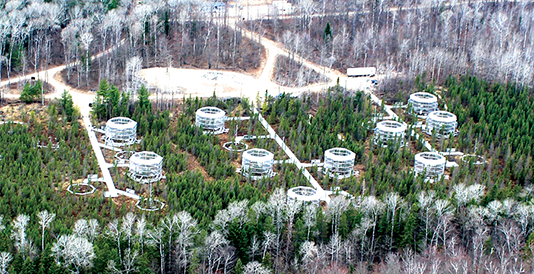 December 13, 2016 (Source: FSU) - Deep stores of carbon in northern peatlands may be safe from rising temperatures, according to a team of researchers from several U.S.-based institutions. And that is good news for now, the researchers said. Florida State University research scientist Rachel Wilson and University of Oregon graduate student Anya Hopple are the first authors on a new study published today in Nature Communications. The study details experiments suggesting that carbon stored in peat — a highly organic material found in marsh or damp regions — may not succumb to the Earth’s warming as easily as scientists thought. That means if these northern peatlands — found in the upper half of the northern hemisphere — remain flooded, a substantial amount of carbon will not be released into the atmosphere.
December 13, 2016 (Source: FSU) - Deep stores of carbon in northern peatlands may be safe from rising temperatures, according to a team of researchers from several U.S.-based institutions. And that is good news for now, the researchers said. Florida State University research scientist Rachel Wilson and University of Oregon graduate student Anya Hopple are the first authors on a new study published today in Nature Communications. The study details experiments suggesting that carbon stored in peat — a highly organic material found in marsh or damp regions — may not succumb to the Earth’s warming as easily as scientists thought. That means if these northern peatlands — found in the upper half of the northern hemisphere — remain flooded, a substantial amount of carbon will not be released into the atmosphere.
Nature Communications Journal Article
Image caption: The SPRUCE research project is spread across seven acres in a natural spruce bog in northern Minnesota. Image credit: Oak Ridge National Laboratory/U.S. Department of Energy
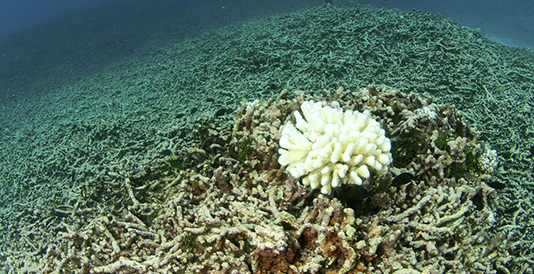 January 5, 2017 (Source: UM) - New climate model projections of the world’s coral reefs reveal which reefs will be hit first by annual coral bleaching, an event that poses the gravest threat to one of the Earth’s most important ecosystems. These high-resolution projections, based on global climate models, predict when and where annual coral bleaching will occur. The projections show that reefs in Taiwan and around the Turks and Caicos archipelago will be among the world’s first to experience annual bleaching. Other reefs, like those off the coast of Bahrain, in Chile and in French Polynesia, will be hit decades later, according to research recently published in the journal Scientific Reports. "Bleaching that takes place every year will invariably cause major changes in the ecological function of coral reef ecosystems," said study leader Ruben van Hooidonk of NOAA and the University of Miami. “Further, annual bleaching will greatly reduce the capacity of coral reefs to provide goods and services, such as fisheries and coastal protection, to human communities.”
January 5, 2017 (Source: UM) - New climate model projections of the world’s coral reefs reveal which reefs will be hit first by annual coral bleaching, an event that poses the gravest threat to one of the Earth’s most important ecosystems. These high-resolution projections, based on global climate models, predict when and where annual coral bleaching will occur. The projections show that reefs in Taiwan and around the Turks and Caicos archipelago will be among the world’s first to experience annual bleaching. Other reefs, like those off the coast of Bahrain, in Chile and in French Polynesia, will be hit decades later, according to research recently published in the journal Scientific Reports. "Bleaching that takes place every year will invariably cause major changes in the ecological function of coral reef ecosystems," said study leader Ruben van Hooidonk of NOAA and the University of Miami. “Further, annual bleaching will greatly reduce the capacity of coral reefs to provide goods and services, such as fisheries and coastal protection, to human communities.”
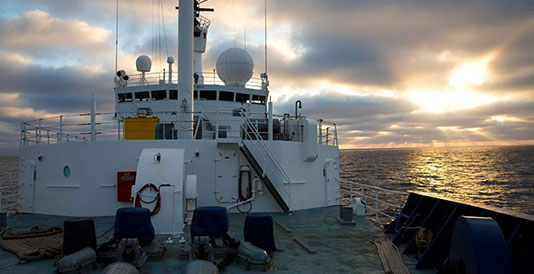 January 23, 2017 (Source: FSU) - A Florida State University researcher is taking a deep dive into the carbon cycle and investigating how carbon moves from the ocean surface to greater depths and then remains there for hundreds of years. Those findings could be critical as scientists work to better understand climate change and how much carbon the Earth’s atmosphere and oceans can store. In a paper published today in the Proceedings of the National Academy of Sciences (PNAS), FSU Assistant Professor Michael Stukel explains how carbon is transported to deeper waters and why it is happening more rapidly in certain areas of the ocean. “Algae in the surface ocean contribute half of the Earth’s photosynthesis, but most of the carbon dioxide they take up gets released back to the atmosphere when they die,” Stukel said. “The only way for this carbon to stay out of the atmosphere for a long period of time is to get it into the deep ocean. If it’s in the deep ocean, it can stay put for hundreds to 1,000 years. As the climate gets warmer, will the ocean take up more carbon dioxide or less? That’s what we ultimately need to know. But first we have to figure out how this natural process of oceanic carbon storage works.”
January 23, 2017 (Source: FSU) - A Florida State University researcher is taking a deep dive into the carbon cycle and investigating how carbon moves from the ocean surface to greater depths and then remains there for hundreds of years. Those findings could be critical as scientists work to better understand climate change and how much carbon the Earth’s atmosphere and oceans can store. In a paper published today in the Proceedings of the National Academy of Sciences (PNAS), FSU Assistant Professor Michael Stukel explains how carbon is transported to deeper waters and why it is happening more rapidly in certain areas of the ocean. “Algae in the surface ocean contribute half of the Earth’s photosynthesis, but most of the carbon dioxide they take up gets released back to the atmosphere when they die,” Stukel said. “The only way for this carbon to stay out of the atmosphere for a long period of time is to get it into the deep ocean. If it’s in the deep ocean, it can stay put for hundreds to 1,000 years. As the climate gets warmer, will the ocean take up more carbon dioxide or less? That’s what we ultimately need to know. But first we have to figure out how this natural process of oceanic carbon storage works.”
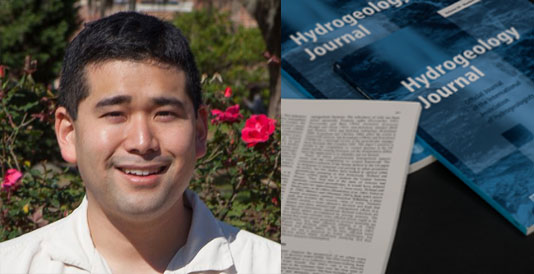 February 13, 2017 (Source: FSU) - A Florida State University researcher has drawn a link between the impact of climate change and untreated drinking water on the rate of gastrointestinal illness in children. Assistant Professor of Geography Chris Uejio has published a first-of-its-kind study, “Drinking-water treatment, climate change, and childhood gastrointestinal illness projections for northern Wisconsin (USA) communities drinking untreated groundwater,” in Hydrogeology Journal. The study explores the benefits of additional drinking water treatment compared to the risks created by climate change. “Most people may not realize this, but there are about 20 million people in the country who access drinking water that isn’t treated,” Uejio said. “These households are particularly vulnerable to rainfall events and contamination events where disease causing pathogens can get in their drinking water sources.”
February 13, 2017 (Source: FSU) - A Florida State University researcher has drawn a link between the impact of climate change and untreated drinking water on the rate of gastrointestinal illness in children. Assistant Professor of Geography Chris Uejio has published a first-of-its-kind study, “Drinking-water treatment, climate change, and childhood gastrointestinal illness projections for northern Wisconsin (USA) communities drinking untreated groundwater,” in Hydrogeology Journal. The study explores the benefits of additional drinking water treatment compared to the risks created by climate change. “Most people may not realize this, but there are about 20 million people in the country who access drinking water that isn’t treated,” Uejio said. “These households are particularly vulnerable to rainfall events and contamination events where disease causing pathogens can get in their drinking water sources.”
 February 13, 2017 (Source: FSU) - A Florida State University researcher is delving into the complexities of exactly how permafrost thawing in the Earth’s most northern regions is cycling back into the atmosphere as carbon dioxide and further fueling climate change. Answer: It has a lot to do with tiny little bugs called microbes and little to do with sunlight.
February 13, 2017 (Source: FSU) - A Florida State University researcher is delving into the complexities of exactly how permafrost thawing in the Earth’s most northern regions is cycling back into the atmosphere as carbon dioxide and further fueling climate change. Answer: It has a lot to do with tiny little bugs called microbes and little to do with sunlight.
Assistant Professor of Earth, Ocean and Atmospheric Science Robert Spencer and a team of researchers traveled to Siberia from 2012 to 2015 to better understand how thawing permafrost affected the carbon cycle. They specifically investigated how the vast amounts of carbon stored in this permafrost transferred to the atmosphere as carbon dioxide.
In a paper published in the American Geophysical Union’s Journal of Geophysical Research-Biogeosciences, Spencer along with Aron Stubbins from the University of Georgia explain that bacteria — or microbes — were the dominant consumer of this carbon. They are gobbling up the carbon from the thawing permafrost and spitting it back out as carbon dioxide. This is in contrast to sunlight, which could also break down the carbon and turn it into carbon dioxide. In their study, researchers found sunlight converted little if any permafrost thawed carbon to carbon dioxide, whereas microbes were shown to rapidly convert permafrost carbon to carbon dioxide.
Journal of Geophysical Research: Biogeosciences Journal Article
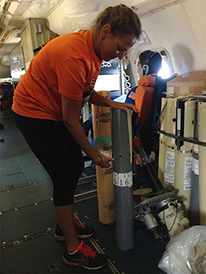 February 15, 2017 (Source: UM/RSMAS) - Last year’s devastating category-5 hurricane—Matthew—may be one of many past examples of a tropical storm fueled by massive rings of warm water that exist in the upper reaches of the Caribbean Sea.
February 15, 2017 (Source: UM/RSMAS) - Last year’s devastating category-5 hurricane—Matthew—may be one of many past examples of a tropical storm fueled by massive rings of warm water that exist in the upper reaches of the Caribbean Sea.
In a study conducted in the region two years prior to when Matthew’s trekked across the Caribbean Sea, the research team in the Upper Ocean Dynamics Laboratory at the University of Miami (UM) Rosenstiel School of Marine and Atmospheric Science (RSMAS) deployed 55 aircraft ocean instruments from the National Oceanographic Atmospheric Administration’s WP-3D aircraft. The purpose of the scientific mission was to measure ocean temperature, salinity, and currents to understand the structure of these warm-water eddies.
The science team obtained vital information about the physical characteristics within one large warm-water eddy, which likely originated from the North Brazil Current, and analyzed its potential influence on sub-surface ocean conditions during the passage of tropical cyclones.
When analyzing the data they found a barrier layer, an upper ocean feature created by the Amazon-Orinoco freshwater river outflow, that makes mixing in the upper ocean waters less efficient during wind events. This feature, and the fact that warm ocean eddies are known to assist in the intensification of hurricanes due to deep warm thermal layers, lead the researchers to theorize that the barrier layer within a warm ocean eddy may result in an even more favorable upper ocean environment for hurricane intensification.
“Our study is important because tropical cyclone intensity forecasts for several past hurricanes over the Caribbean Sea have under-predicted rapid intensification events over warm oceanic features,” said Johna Rudzin, a PhD student at the UM Rosenstiel School and lead author of the study.
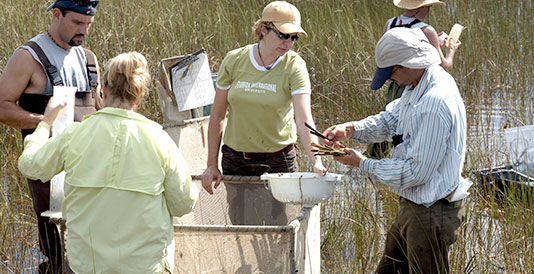 February 22, 2017 (Source: FIU) - Researchers are taking a step back to answer the question whether long-term studies are helping save plants, animals and the places they call home. The global answer is yes. FIU researchers are gathering data in the Florida Everglades that provide critical information needed for restoration and conservation. They’ve been doing this for more than a decade.
February 22, 2017 (Source: FIU) - Researchers are taking a step back to answer the question whether long-term studies are helping save plants, animals and the places they call home. The global answer is yes. FIU researchers are gathering data in the Florida Everglades that provide critical information needed for restoration and conservation. They’ve been doing this for more than a decade.
The Everglades is made up of different ecosystems, including swamps, hardwood hammocks, mangrove forests, pine rocklands and sawgrass marshes. Their interconnectivity makes them especially susceptible to changes in the environment.
FIU’s long-term approach to studying the Everglades allows scientists to understand how it works, and it allows them to predict how it will respond to changes in the future. For more than 16 years, scientists in FIU’s Florida Coastal Everglades Long Term Ecological Research (FCE LTER) Program have been studying how water, climate and people affect the Everglades. Their efforts have resulted in more than 500 peer-reviewed journal articles to date.
In a new paper, FIU researchers outline the value of international long-term research, how it has played into what is known about the Everglades and other wetlands, and how it can help solve current and future ecological problems. It is part of a four-paper special feature on international long term ecological research published in Ecosphere.
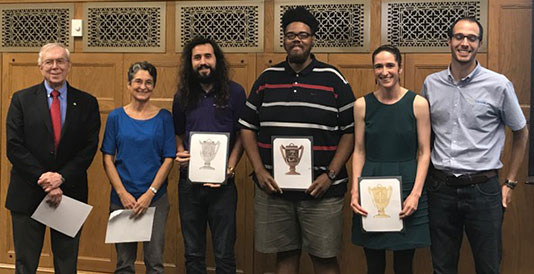 March 1, 2017 (Source: UF) - The Florida Climate Institute at the University of Florida hosted a 3-Minute Thesis/2-Minute Video Competition on February 28 in which graduate students presented their climate-related research. The event included students from several disciplines who all needed to use one slide to create a compelling story about the importance of their research for a lay audience.
March 1, 2017 (Source: UF) - The Florida Climate Institute at the University of Florida hosted a 3-Minute Thesis/2-Minute Video Competition on February 28 in which graduate students presented their climate-related research. The event included students from several disciplines who all needed to use one slide to create a compelling story about the importance of their research for a lay audience.
The winners of the 3mt/2mv contest were:
3MT:
1st place-- Sinead Crotty, PhD student for Synergistic interaction between sea-level rise and predator depletion drives regional salt marsh loss
2nd place--Jose Rafael Guarin. PhD student for Validating the NWheat crop model with historical extreme events
3rd place--Elliott White Jr. for Quantifying the impacts of chronic, low-level salinity on bald cypress swamps along the northern Gulf of Mexico
2MV:
Eduardo Montiero Gelcer for Climate smart agriculture: a tool to monitor crop development and weather to reduce risks in the southeast USA
Watch the presentations here.
Photo (left to right): Jim Jones, Ellen Martin, Jose Guarin, Elliott White Jr., Sinead Crotty, Eduardo Gelcer
 March 1, 2017 - The Florida Climate Institute is pleased to welcome Nova Southeastern University (NSU) in Fort Lauderdale, FL, as our 10th member university. The NSU FCI branch will be directed by Dr. Bernard Riegl of the Halmos College of Natural Sciences and Oceanography, Department of Marine and Environmental Sciences, and Dr. Thomas Wuerzer of the Huizenga College of Business and Entrepreneurship.
March 1, 2017 - The Florida Climate Institute is pleased to welcome Nova Southeastern University (NSU) in Fort Lauderdale, FL, as our 10th member university. The NSU FCI branch will be directed by Dr. Bernard Riegl of the Halmos College of Natural Sciences and Oceanography, Department of Marine and Environmental Sciences, and Dr. Thomas Wuerzer of the Huizenga College of Business and Entrepreneurship.
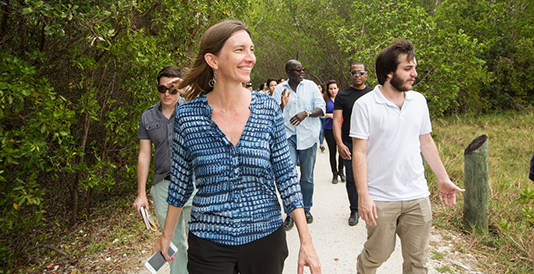 March 28, 2017 - The National Academies of Sciences, Engineering, and Medicine has appointed a committee of experts, including Tiffany Troxler of FIU, to conduct a study on Developing a Research Agenda on Carbon Dioxide Removal and Reliable Sequestration.
March 28, 2017 - The National Academies of Sciences, Engineering, and Medicine has appointed a committee of experts, including Tiffany Troxler of FIU, to conduct a study on Developing a Research Agenda on Carbon Dioxide Removal and Reliable Sequestration.
Reaching lower global temperature targets recently set by the international community to avoid climate risks may require removing greenhouse gas that's already accumulated. However, many of the proposed carbon dioxide removal (CDR) technologies are not yet viable in terms of cost and scalability, and any potential risks are not fully understood.
This study will develop the detailed research and development agenda needed to assess the benefits, risks, and sustainable scale potential for CDR and sequestration approaches and increase their commercial viability. Approaches considered will include land management, accelerated weathering, bioenergy with capture, direct air capture, geologic sequestration, and blue carbon, among others.
The committee slate is provisional pending a public comment period and final approval by the National Academies.
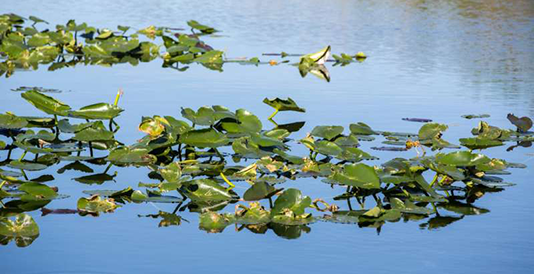 March 30, 2017 (Source: FIU) - The carbon dioxide coming from some of Earth’s tiniest residents may not be increasing as quickly as some believed in the face of global climate change. Streams and rivers are home to insects, bacteria and fungi that consume plant litter, including fallen leaves, and break it into smaller pieces. This type of litter is good for streams and rivers because it helps remove toxins. As leaf litter is consumed, insects and microbes get oxygen, convert nutrients into energy and release carbon dioxide into the atmosphere. This process is what scientists call leaf litter decay.
March 30, 2017 (Source: FIU) - The carbon dioxide coming from some of Earth’s tiniest residents may not be increasing as quickly as some believed in the face of global climate change. Streams and rivers are home to insects, bacteria and fungi that consume plant litter, including fallen leaves, and break it into smaller pieces. This type of litter is good for streams and rivers because it helps remove toxins. As leaf litter is consumed, insects and microbes get oxygen, convert nutrients into energy and release carbon dioxide into the atmosphere. This process is what scientists call leaf litter decay.
According to a recently released study, temperature is not the only factor in how quickly insects and micro-organisms convert their food into energy and, as a byproduct, release carbon dioxide into the air. This finding contradicts a long-held belief that this process would accelerate with rising temperatures. Understanding how plant matter breaks down in different environments can help scientists predict how ecosystems will respond to climate change.
“If you have a reliable source of energy for organisms in an ecosystem, like the energy provided by consuming leaf litter, the communities of animals and plants living there will be more persistent,” said John Kominoski, an FIU biologist and co-author of the study. “Since global temperatures are rising and leaf litter decay is not as sensitive to temperature as once believed, it gives us hope ecosystems won’t be as energy-limited as we had thought.”
 April 5, 2017 (Source: FSU) - Jeffrey Chanton, an acclaimed climate scientist who has also done extensive work investigating the effects of the BP oil spill, has been named the 2017-2018 Robert O. Lawton Distinguished Professor, the highest honor given by the Florida State University faculty to one of its own.
April 5, 2017 (Source: FSU) - Jeffrey Chanton, an acclaimed climate scientist who has also done extensive work investigating the effects of the BP oil spill, has been named the 2017-2018 Robert O. Lawton Distinguished Professor, the highest honor given by the Florida State University faculty to one of its own.
“Jeff is a tremendous researcher and an asset to the Florida State University faculty,” said FSU President John Thrasher. “In addition to an impressive research record, Jeff is an outstanding colleague to his fellow faculty members and mentor to his students. The faculty has made an excellent choice in naming Jeff this year’s Lawton Distinguished Professor.”
Chanton is the John Widmer Winchester Professor of Oceanography in the Department of Earth, Ocean and Atmospheric Science, which is part of the College of Arts and Sciences. He is a 29-year veteran of the university and a fellow of the American Geophysical Union.
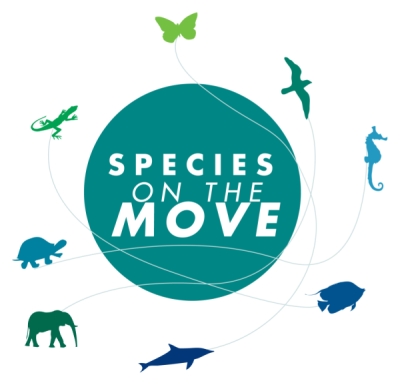 April 5, 2017 - Changes in the distribution of land, marine and freshwater species as a result of climate change are affecting human wellbeing around the world, posing new health risks, economics threats and conflicts over resources. The study, by an international team, including Brett Scheffers (UF), is published in the journal Science. In response to climate change, land-based species are moving towards the poles by 17 kilometres per decade, and marine species by 72 kilometres per decade, on average.
April 5, 2017 - Changes in the distribution of land, marine and freshwater species as a result of climate change are affecting human wellbeing around the world, posing new health risks, economics threats and conflicts over resources. The study, by an international team, including Brett Scheffers (UF), is published in the journal Science. In response to climate change, land-based species are moving towards the poles by 17 kilometres per decade, and marine species by 72 kilometres per decade, on average.
The Science article was the result of the international Species on the Move conference co-organized by Scheffers and held in Hobart, Tasmania, in February 2016. The conference brought together approximately 350 international scientists to discuss the global redistribution of species due to climate change.
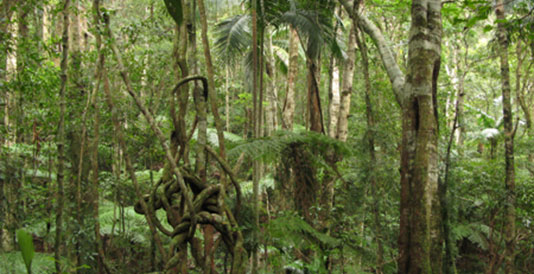 April 10, 2017 (Source: Brett Scheffers) - Dispersal has become one of the most studied traits in ecology and conservation as scientists attempt to understand species distributions and species resilience to environmental instability. A paper led by Brett Scheffers (UF) and recently published in Global Ecology and Biogeography presents a new trait associated with resilience to environment instability—arboreality.
April 10, 2017 (Source: Brett Scheffers) - Dispersal has become one of the most studied traits in ecology and conservation as scientists attempt to understand species distributions and species resilience to environmental instability. A paper led by Brett Scheffers (UF) and recently published in Global Ecology and Biogeography presents a new trait associated with resilience to environment instability—arboreality.
Here, the authors show that vertical (arboreality) and horizontal (dispersal) movement are closely linked and together they increase the resilience of vertebrates to climatic instability in the wet tropical rainforests of Australia.
The authors also present a new climate dimension to biogeography—the microclimate created by trees. Here, they monitored temperature from ground to canopy in tropical rainforests across elevation. They show that low- and high-altitude arboreal species experience similar thermal regimes, whereas low- and high-altitude ground-dwelling species experience little overlap in thermal regimes.
Following the spirit of Janzen’s hypothesis (1967-Mountain passes are higher in the tropics), the researchers found that temperature regimes in canopies are effectively less differentiated across geographical space than on the ground due to greater overlap in hot thermal regimes in the canopy. As such, arboreality (and its strong interaction with horizontal dispersal) may be a critical trait mediating the extinction proneness of species to past and future environmental instability.
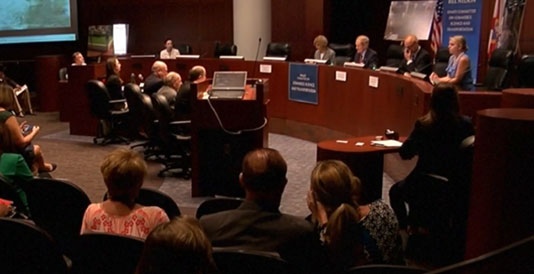 April 11, 2017 - U.S. Sen. Bill Nelson (D-Fla.), the ranking member of Senate Committee on Commerce, Science, and Transportation convened a full committee field hearing titled “Extreme Weather and Coastal Flooding: What is Happening Now, What is the Future Risk, and What Can We Do About It?”on Monday, April 10, 2017 at 1:30 p.m. EDT in West Palm Beach, Florida.
April 11, 2017 - U.S. Sen. Bill Nelson (D-Fla.), the ranking member of Senate Committee on Commerce, Science, and Transportation convened a full committee field hearing titled “Extreme Weather and Coastal Flooding: What is Happening Now, What is the Future Risk, and What Can We Do About It?”on Monday, April 10, 2017 at 1:30 p.m. EDT in West Palm Beach, Florida.
The hearing examined the impacts of sea level rise and extreme weather events. Since 2006, sea level rise in southeast Florida has tripled, averaging about nine millimeters a year. The resulting impacts of coastal flooding, saltwater intrusion, storm surge, and land erosion on Florida’s coastal communities have prompted local governments to act. Following Hurricane Sandy, Palm Beach County restored over 20 acres of beach and sand-dunes to protect shoreside communities from flooding and severe weather. Sen. Nelson led a discussion on the economic impacts of extreme weather and coastal flooding to communities, as well as future risks and efforts to address the problems.
The field hearing included 2 witnesses from the Florida Climate Institute: Dr. Ben Kirtman (UM) and Dr. Len Berry (Coastal Risk Consulting; FAU). The full witness testimonies are available at the hearing webpage link below.
Witnesses:
- *Dr. Ben Kirtman, PhD, Director of the Cooperative Institute for Marine and Atmospheric Sciences; and Director of the Center for Computational Science, Climate, and Environmental Hazards at the University of Miami
- *Dr. Leonard “Len” Berry, PhD, Emeritus Professor of Geosciences at Florida Atlantic University; and Vice President of Government Programs at Coastal Risk Consulting, LLC
- Mr. Carl G. Hedde, CPCU, Senior Vice President; and Head of Risk Accumulation and Munich Reinsurance Company of America
- Dr. Jennifer Jurado, PhD, Chief Resiliency Officer; and Director of Environmental Planning and Community Resilience at Broward County
*FCI Researcher
 April 24, 2017 (Source: CLASS Fund) - The California Landscape Architectural Student Scholarship Fund (CLASS Fund) Selection Committee is pleased to announce that the 2016-17 CLASS Fund Grant Award goes to Professor Michael Volk and his research team for a project entitled, Incorporating Climate Change into Landscape Architectural Projects and Practice.
April 24, 2017 (Source: CLASS Fund) - The California Landscape Architectural Student Scholarship Fund (CLASS Fund) Selection Committee is pleased to announce that the 2016-17 CLASS Fund Grant Award goes to Professor Michael Volk and his research team for a project entitled, Incorporating Climate Change into Landscape Architectural Projects and Practice.
Professor Volk from the Department of Landscape Architecture at University of Florida will lead an interdisciplinary research team to examine Landscape Architects’ roles in mitigating climate change impacts and alternative design and implementation practices in the state of Florida. Using data from a recent survey on attitudes and perceptions of Florida landscape architects toward climate change, Professor Volk’s study will identify information gaps and possible barriers to adoption of landscape design practices that anticipate and plan for climate change, as well as potential strategies that can be used to mitigate and adapt to the impacts of climate change on the built and natural environment.
Professor Michael Volk commented that, “landscape architects have a significant role in addressing climate change in their work and practice, and many landscape architects are already doing so. We greatly appreciate the support of the CLASS Fund and CELA in this project, and look forward to continuing our work to advance knowledge in this area.”
Other members on the research team include: Professor Gail Hansen, Department of Environmental Horticulture, University of Florida, and Belinda Nettles, PhD Candidate, Center for Landscape Conservation Planning & Levin College of Law Conservation Clinic, University of Florida.
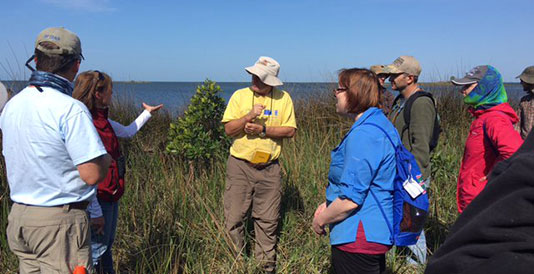 April 26, 2017 - The first Florida Climate Institute Field Course was held this spring and hosted by the University of Florida. The course, titled Sea Level Rise and Coastal Ecology: Science, Policy, and Practice, was formed in order to provide opportunities for graduate students to practice collaborating across disciplines to solve complex natural resource problems. There were five interdisciplinary groups that consisted of three students from distinct programs of study: one student from the Levin College of Law, one student from the College of Agriculture and Life Sciences, and one student from the College of Liberal Arts and Sciences. Each group was assigned a case study of local relevance to natural resources in the Big Bend region. Each natural resource case study was associated with problems presented by sea-level rise and climate change in the region.
April 26, 2017 - The first Florida Climate Institute Field Course was held this spring and hosted by the University of Florida. The course, titled Sea Level Rise and Coastal Ecology: Science, Policy, and Practice, was formed in order to provide opportunities for graduate students to practice collaborating across disciplines to solve complex natural resource problems. There were five interdisciplinary groups that consisted of three students from distinct programs of study: one student from the Levin College of Law, one student from the College of Agriculture and Life Sciences, and one student from the College of Liberal Arts and Sciences. Each group was assigned a case study of local relevance to natural resources in the Big Bend region. Each natural resource case study was associated with problems presented by sea-level rise and climate change in the region.
To view a video about the course, please visit https://youtu.be/IPTyZIrwhUw.
For more information and to download course materials, please visit https://floridaclimateinstitute.org/projects/2017-field-course.
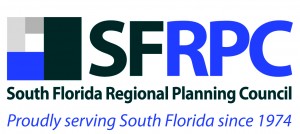 April 24, 2017 - The South Florida Regional Planning Council (SFRPC) and Keren Bolter are pleased to announce the following project updates:
April 24, 2017 - The South Florida Regional Planning Council (SFRPC) and Keren Bolter are pleased to announce the following project updates:
An Actionable Tool to Map Future Expansion of the Coastal High Hazard Area: Translating Science to Policy in Planning for Sea-Level Rise and Storm Surge in the Florida Keys with a focus on Islamorada, Village of Islands
SFRPC was awarded a grant from the Gulf of Mexico Alliance to create an interactive tool to map surge vulnerability. This study will focus on the Florida Keys’ exposure to sea-level rise, and more importantly, storm surge, using recently released Sea, Lake, and Overland Surges from Hurricane (SLOSH) data modeled at various scenarios. Results will be made available on an interactive website, and there will be a series of stakeholder engagement opportunities.
Trainers and Tools: Building Coastal Flood Hazard Resiliency in Florida’s Regional Planning Council Communities Project: Capacity Building through Technical Assistance and Outreach
This project was created to educate and promote four coastal flood hazard assessment tools: NOAA’s Sea Level Rise Viewer, Coastal Flood Exposure Mapper, and CanVis Tools, as well as FDOT/UF’s Geoplan Sketch Planning Tool. The project was coordinated with regional trainings and vulnerability assessments conducted throughout Florida’s ten regional planning councils. Outcomes included enhanced communication, stakeholder engagement, intergovernmental coordination, and an overall increase in Florida’s adaptive capacity for coastal resilience. For more information, please visit the project webpage.
Improving the Planning Process to Protect Infrastructure from Emerging Coastal Flood Hazards
In producing a series of Infrastructure Protection Resources, SFRPC aimed to provide technical assistance to local governments wishing to increase resilience to coastal flooding, particularly during extreme events such as high tides and storm surge. In the first part of the project, SFRPC documented the process of in situ measurement and modeling of current and projected Fall King Tide flooding in six pilot communities: Dania Beach, Hollywood, North Miami, North Bay Village, Key Largo, and Islamorada. The second set of resources documented structure surveys given to local public works staff, city managers, and other relevant stakeholders, to understand the current state of infrastructure in 6 pilot communities, as well as key challenges and solutions. The final resource, set for completion in June 2017, focuses on one community, North Bay Village. The SFRPC and Village staff plan to prepare and transmit a comprehensive plan amendment(s) which address deficiencies in the Village’s response to Peril of Flood. This amendment will include best available data, including new storm surge data from the Sea, Lake, and Overland Surges from Hurricanes (SLOSH) model to designate the Coastal High Hazard Area. For more information, please visit the project webpage.
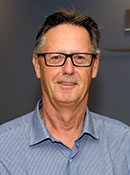 April 27, 2017 - Anton Post, Ph.D. has been appointed as the executive director of FAU Harbor Branch, leading Environmental and Ocean Science research at FAU. Post will focus on a new strategic effort to develop interdisciplinary research combining expertise across many FAU centers and colleges including: FAU Harbor Branch; Institute for Sensing and Embedded Network Systems Engineering (I-SENSE); SeaTech: Institute for Ocean and Systems Engineering; Florida Center for Environmental Studies; Charles E. Schmidt College of Science and the College of Engineering and Computer Science.
April 27, 2017 - Anton Post, Ph.D. has been appointed as the executive director of FAU Harbor Branch, leading Environmental and Ocean Science research at FAU. Post will focus on a new strategic effort to develop interdisciplinary research combining expertise across many FAU centers and colleges including: FAU Harbor Branch; Institute for Sensing and Embedded Network Systems Engineering (I-SENSE); SeaTech: Institute for Ocean and Systems Engineering; Florida Center for Environmental Studies; Charles E. Schmidt College of Science and the College of Engineering and Computer Science.
The world renowned oceanographer and leading phytoplankton researcher previously served as the executive director of the University of Rhode Island's Coastal Resources Center, Graduate School of Oceanography. FAU is in its fifth decade of working with marine science and technology partners on applied projects that produce positive environmental, societal and economic outcomes.
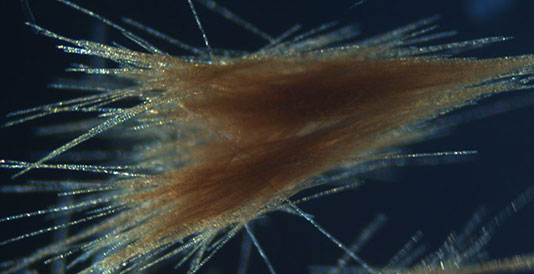 May 3, 2017 (Source: FSU) - Climate change may be putting cyanobacteria that are crucial to the functioning of the ocean at risk as the amount of carbon dioxide in the atmosphere increases and the acidity of ocean water changes. In a paper published in Science, a team of researchers from Florida State University, Xiamen University in China and Princeton University argue that the acidification of seawater caused by rising carbon dioxide levels makes it difficult for a type of cyanobacteria to perform a process called nitrogen fixation. Few people know much about a type of cyanobacteria called Trichodesmium, but this miniscule collection of cells is critical to the health of hundreds of species in the Earth’s oceans. Through nitrogen fixation, Trichodesmium converts nitrogen gas into ammonia and other molecules that organisms are dependent on for survival. Trichodesmium is thought to be responsible for about 50 percent of marine nitrogen fixation, so a decline in its ability could have a major ripple effect on marine ecosystems. “This is one of the major sources of nitrogen for other organisms in the open ocean,” said Sven Kranz, assistant professor of Earth, Ocean and Atmospheric Science at Florida State University and a co-author of this study. “If Trichodesmium responds negatively to the environmental changes forced upon the ocean by fossil fuel burning, it could have a large effect on our food web.”
May 3, 2017 (Source: FSU) - Climate change may be putting cyanobacteria that are crucial to the functioning of the ocean at risk as the amount of carbon dioxide in the atmosphere increases and the acidity of ocean water changes. In a paper published in Science, a team of researchers from Florida State University, Xiamen University in China and Princeton University argue that the acidification of seawater caused by rising carbon dioxide levels makes it difficult for a type of cyanobacteria to perform a process called nitrogen fixation. Few people know much about a type of cyanobacteria called Trichodesmium, but this miniscule collection of cells is critical to the health of hundreds of species in the Earth’s oceans. Through nitrogen fixation, Trichodesmium converts nitrogen gas into ammonia and other molecules that organisms are dependent on for survival. Trichodesmium is thought to be responsible for about 50 percent of marine nitrogen fixation, so a decline in its ability could have a major ripple effect on marine ecosystems. “This is one of the major sources of nitrogen for other organisms in the open ocean,” said Sven Kranz, assistant professor of Earth, Ocean and Atmospheric Science at Florida State University and a co-author of this study. “If Trichodesmium responds negatively to the environmental changes forced upon the ocean by fossil fuel burning, it could have a large effect on our food web.”
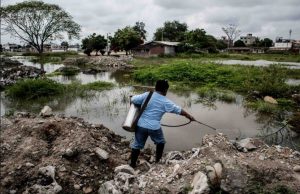 May 10, 2017 (Source: UF) - New research co-authored by USF's Jeremy Cohen, Leah Johnson, and Jason Rohr and UF's Sadie Ryan and Cat Lippi sheds light on the climate suitability for Aedes aegypti and Aedes albopictus mosquitos and transmission rates of Zika, chikungunya, and dengue fever.
May 10, 2017 (Source: UF) - New research co-authored by USF's Jeremy Cohen, Leah Johnson, and Jason Rohr and UF's Sadie Ryan and Cat Lippi sheds light on the climate suitability for Aedes aegypti and Aedes albopictus mosquitos and transmission rates of Zika, chikungunya, and dengue fever.
The study, published in PLOS Neglected Tropical Diseases compares new data driven models of Zika, chikungunya, and dengue fever transmission to real world measurements of human infections caused by bites from Aedes aegypti and Ae. Albopictus mosquitoes. These models confirm that temperature is the single most important factor for predicting the rate and geographic spread of epidemics of these mosquito-borne diseases. Temperature influences transmissibility in many ways – affecting the lifespan of an individual mosquito, and determining biting frequency and the reproductive rate of the virus within the mosquito.
The collaborative research team includes experts in epidemiology, public health, ecology, mathematical modeling, and geography, and was funded by a grant from the National Science Foundation’s Ecology and Evolution of Infectious Disease program (NSF-DEB 1518681).
PLOS Neglected Tropical Diseases Journal Article
Image: Aedes control – image courtesy Mr. Dany Krom
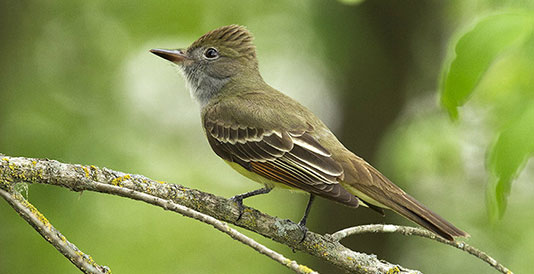 May 15, 2017 (Source: UF) - Climate change is altering the delicate seasonal clock that North American migratory songbirds rely on to successfully mate and raise healthy offspring, setting in motion a domino effect that could threaten the survival of many familiar backyard bird species, new research shows. A growing shift in the onset of spring has left nine of 48 species of songbirds studied unable to reach their northern breeding grounds at the calendar marks critical for producing the next generation of fledglings, according to a paper published today in Scientific Reports.
May 15, 2017 (Source: UF) - Climate change is altering the delicate seasonal clock that North American migratory songbirds rely on to successfully mate and raise healthy offspring, setting in motion a domino effect that could threaten the survival of many familiar backyard bird species, new research shows. A growing shift in the onset of spring has left nine of 48 species of songbirds studied unable to reach their northern breeding grounds at the calendar marks critical for producing the next generation of fledglings, according to a paper published today in Scientific Reports.
“It’s like ‘Silent Spring,’ but with a more elusive culprit,” said Stephen Mayor, a postdoctoral researcher with the Florida Museum of Natural History at the University of Florida and first author of the study. “We’re seeing spring-like conditions well before birds arrive. The growing mismatch means fewer birds are likely to survive, reproduce and return the following year. These are birds people are used to seeing and hearing in their backyards. They’re part of the American landscape, part of our psyche. To imagine a future where they’re much less common would be a real loss.”
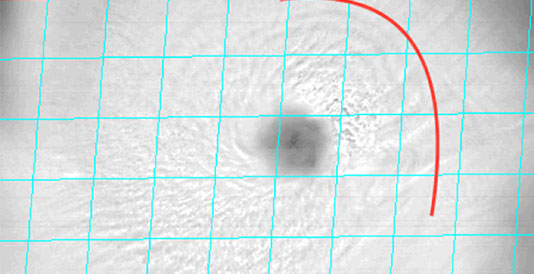 May 15, 2017 (Source: UM RSMAS) - Researchers believe they have found a new way to monitor the intensity and location of hurricanes from hundreds of miles away by detecting atmospheric waves radiating from the centers of these powerful storms.
May 15, 2017 (Source: UM RSMAS) - Researchers believe they have found a new way to monitor the intensity and location of hurricanes from hundreds of miles away by detecting atmospheric waves radiating from the centers of these powerful storms.
In a new study, scientists from the University of Miami (UM) Rosenstiel School of Marine and Atmospheric Science and the Hurricane Research Division of the National Oceanic and Atmospheric Administration (NOAA) presented direct observations of the waves, obtained by NOAA aircraft flying in hurricanes and by a research buoy located in the Pacific Ocean. The waves, known as atmospheric gravity waves, are produced by strong thunderstorms near the eye and radiate outward in expanding spirals.
“These very subtle waves can sometimes be seen in satellite images,” said David Nolan, professor in the Department of Atmospheric Sciences, and lead author of the study. “We were able to measure them in aircraft data and surface instruments.”
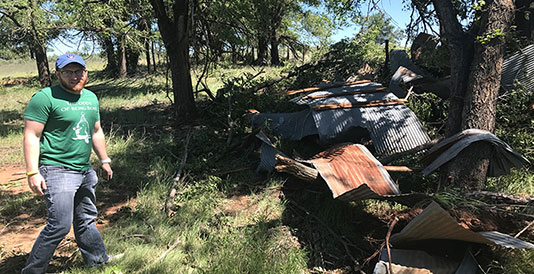 May 24, 2017 (Source: FSU) - New research out of Florida State University shows that the strength of a tornado has a significantly larger effect than population on the number of casualties. “It’s somewhat surprising because we’re led to believe it’s just a problem with exposure — the more people in the way the more casualties,” said James Elsner, chair of the FSU Department of Geography and Earl & Sofia Shaw Professor. That’s not the case, according to this latest study. Using a regression model, researchers found that on average a doubling of the population under the path of a tornado leads to a 21 percent increase in the casualty rate, while a doubling of the energy dispersed by the tornado leads to a 33 percent increase in the casualty rate.
May 24, 2017 (Source: FSU) - New research out of Florida State University shows that the strength of a tornado has a significantly larger effect than population on the number of casualties. “It’s somewhat surprising because we’re led to believe it’s just a problem with exposure — the more people in the way the more casualties,” said James Elsner, chair of the FSU Department of Geography and Earl & Sofia Shaw Professor. That’s not the case, according to this latest study. Using a regression model, researchers found that on average a doubling of the population under the path of a tornado leads to a 21 percent increase in the casualty rate, while a doubling of the energy dispersed by the tornado leads to a 33 percent increase in the casualty rate.
 May 31, 2017 (Source: FIU) - Florida leads the south in water efficiency, according to a study examining water use across the United States. While states in the north have become more water efficient, their southern counterparts have not. Florida is the exception with water use in homes, business and public spaces declining over the past 30 years in the Sunshine State. Broward and Palm Beach were the most efficient counties, while Hardee and DeSoto were the least efficient. These findings are consistent with the national findings that show increased water efficiency in urban areas while rural areas have become less efficient. "Florida is the third most populous state in the country and it is largely urban, which accounts for its higher water efficiency compared to other southern states," said FIU biologist John Kominoski, a co-author of the study.
May 31, 2017 (Source: FIU) - Florida leads the south in water efficiency, according to a study examining water use across the United States. While states in the north have become more water efficient, their southern counterparts have not. Florida is the exception with water use in homes, business and public spaces declining over the past 30 years in the Sunshine State. Broward and Palm Beach were the most efficient counties, while Hardee and DeSoto were the least efficient. These findings are consistent with the national findings that show increased water efficiency in urban areas while rural areas have become less efficient. "Florida is the third most populous state in the country and it is largely urban, which accounts for its higher water efficiency compared to other southern states," said FIU biologist John Kominoski, a co-author of the study.
 June 1, 2017 (Source: USF) - The 2016 hurricane season was the longest hurricane season since 1951, making it the second-longest hurricane season on record. That’s the conclusion drawn in a paper just published in Geophysical Research Letters. Lead author Jennifer Collins, PhD, associate professor in the School of Geosciences at the University of South Florida, writes: “Overall 2016 was notable for a series of extremes, some rarely and a few never before observed in the Atlantic basin, a potential harbinger of seasons to come in the face of ongoing global climate change.” The study examines 15 tropical storms, seven hurricanes and three intense hurricanes. The season was slightly above average when considering Accumulated Cyclone Energy (ACE), which the National Oceanic and Atmospheric Administration (NOAA) uses to measure cyclonic activity.
June 1, 2017 (Source: USF) - The 2016 hurricane season was the longest hurricane season since 1951, making it the second-longest hurricane season on record. That’s the conclusion drawn in a paper just published in Geophysical Research Letters. Lead author Jennifer Collins, PhD, associate professor in the School of Geosciences at the University of South Florida, writes: “Overall 2016 was notable for a series of extremes, some rarely and a few never before observed in the Atlantic basin, a potential harbinger of seasons to come in the face of ongoing global climate change.” The study examines 15 tropical storms, seven hurricanes and three intense hurricanes. The season was slightly above average when considering Accumulated Cyclone Energy (ACE), which the National Oceanic and Atmospheric Administration (NOAA) uses to measure cyclonic activity.
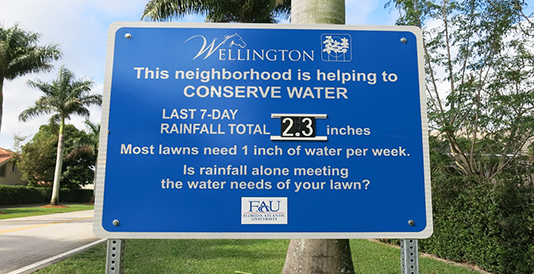 June 20, 2017 (Source: FAU) - Rain or shine has new meaning thanks to an innovative, inexpensive and simple tactic developed by researchers at Florida Atlantic University that will really change how people think about watering their lawns. The tactic? A straightforward road sign.
June 20, 2017 (Source: FAU) - Rain or shine has new meaning thanks to an innovative, inexpensive and simple tactic developed by researchers at Florida Atlantic University that will really change how people think about watering their lawns. The tactic? A straightforward road sign.
Outdoor water restrictions are a common water conservation strategy in the United States, Canada, Australia and other countries to address water use as it relates to maintaining lawns and greenspace. In fact, 29 states in the U.S. have outdoor water restrictions that only allow lawn watering on certain days or times. Conserving water is critical because 50 to 90 percent of household water is used for this purpose. Furthermore, to provide each South Florida lawn with the necessary one-inch of water per week, it takes more than 62 gallons of water for every 10-foot-by-10-foot area.
However, this one-pronged approach of water restrictions that involves pre-set and arbitrary lawn-watering schedules does not always result in actual water savings so Tara Root, Ph.D., associate professor in the Department of Geosciences in FAU’s Charles E. Schmidt College of Science, and Felicia D. Survis, who recently earned her Ph.D. at FAU, decided to do some research.
For two years, which included two annual wet and dry seasons, they conducted a unique study in Wellington, a suburban village in South Florida, to demonstrate how you can save a lot of water by simply providing people with more information than just directives, schedules or guidelines about which days of the week they can water their lawns. Wellington provided the perfect venue for this study since the village is located in a region that has distinct wet and dry seasons and that is subject to permanent year-round mandatory water restrictions. Additionally, Wellington was interested in the research and helped to implement the pilot program. Results of their study are published in the current issue of the Journal of Environmental Management.
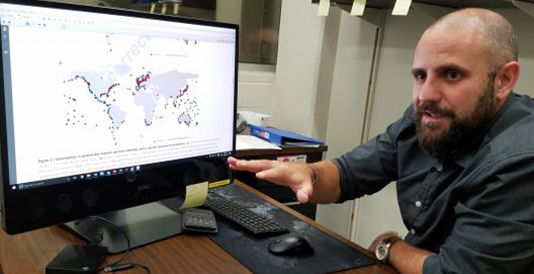 July 7, 2017 (Source: UCF) - Improving projections for how much ocean levels may change in the future and what that means for coastal communities has vexed researchers studying sea level rise for years, but a new international study that incorporates extreme events may have just given researchers and coastal planners what they need.
July 7, 2017 (Source: UCF) - Improving projections for how much ocean levels may change in the future and what that means for coastal communities has vexed researchers studying sea level rise for years, but a new international study that incorporates extreme events may have just given researchers and coastal planners what they need.
The study, published today in Nature Communications uses newly available data and advanced models to improve global predictions when it comes to extreme sea levels. The results suggest that extreme sea levels will likely occur more frequently than previously predicted, particularly in the west coast regions of the U.S. and in large parts of Europe and Australia.
“Storm surges globally lead to considerable loss of life and billions of dollars of damages each year, and yet we still have a limited understanding of the likelihood and associated uncertainties of these extreme events both today and in the future,” said Thomas Wahl, an assistant engineering professor in the University of Central Florida who led the study.
 July 14, 2017 (Source: FSU) - Scientists have long believed that the waters of the Central and Northeast Pacific Ocean were inhospitable to deep-sea scleractinian coral, but a Florida State University professor’s discovery of an odd chain of reefs suggests there are mysteries about the development and durability of coral colonies yet to be uncovered. Associate Professor of Earth, Ocean and Atmospheric Science Amy Baco-Taylor, in collaboration with a team from Texas A&M University, observed these reefs during an autonomous underwater vehicle survey through the seamounts of the Northwestern Hawaiian Islands.
July 14, 2017 (Source: FSU) - Scientists have long believed that the waters of the Central and Northeast Pacific Ocean were inhospitable to deep-sea scleractinian coral, but a Florida State University professor’s discovery of an odd chain of reefs suggests there are mysteries about the development and durability of coral colonies yet to be uncovered. Associate Professor of Earth, Ocean and Atmospheric Science Amy Baco-Taylor, in collaboration with a team from Texas A&M University, observed these reefs during an autonomous underwater vehicle survey through the seamounts of the Northwestern Hawaiian Islands.
In an article published today in the journal Scientific Reports, Baco-Taylor and her team document these reefs and discuss possible explanations for their appearance in areas considered impossibly hostile to reef-forming scleractinia, whose communities are formed by small, stony polyps that settle on the seabed and grow bony skeletons to protect their soft bodies. If there are additional reefs sprinkled across the Northwestern Hawaiian seamounts, Baco-Taylor wants to find them. Further study of these reefs could reveal important secrets about how these organisms might endure in the age of climbing carbon dioxide levels and ocean acidification. “If more of these reefs are there, that would run counter to what ocean acidification and carbonate chemistry dictates,” Baco-Taylor said. “It leaves us with some big questions: Is there something that we’re not understanding? How is this possible?”
 July 19, 2017 (Source: FSU) - For more than a decade, people have used social media to express themselves and inform and engage users across the globe. Now, a new study by Florida State University researchers examines the impact rising temperatures have on Twitter activity, and how government officials use the social media tool to warn the general public of heatwave conditions.
July 19, 2017 (Source: FSU) - For more than a decade, people have used social media to express themselves and inform and engage users across the globe. Now, a new study by Florida State University researchers examines the impact rising temperatures have on Twitter activity, and how government officials use the social media tool to warn the general public of heatwave conditions.
FSU doctoral student Jihoon Jung and Assistant Professor of Geography Chris Uejio co-authored the paper published this month in the International Journal of Biometeorology. They found in Atlanta, Los Angeles and New York City that as temperatures rose, the number of temperature-related tweets increased.
“If more agencies start to include social media and tap into what people are actually experiencing in real time, they can improve their extreme heat early warning systems,” Uejio said. “We are also hoping that these government groups will start to include more health information in their social media messaging.”
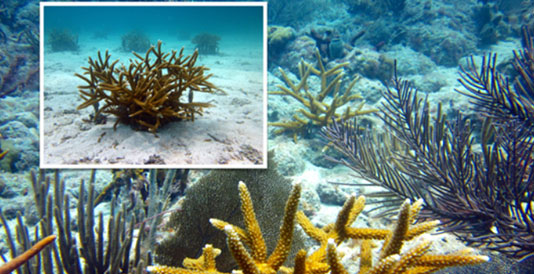 July 25, 2017 (Source: UM/RSMAS) - A new study found that Caribbean staghorn corals (Acropora cervicornis) are benefiting from “coral gardening,” the process of restoring coral populations by planting laboratory-raised coral fragments on reefs. The research, led by scientists at the University of Miami, Nova Southeastern University, and additional partners, has important implications for the long-term survival of coral reefs worldwide, which have been in worldwide decline from multiple stressors such as climate change and ocean pollution.
July 25, 2017 (Source: UM/RSMAS) - A new study found that Caribbean staghorn corals (Acropora cervicornis) are benefiting from “coral gardening,” the process of restoring coral populations by planting laboratory-raised coral fragments on reefs. The research, led by scientists at the University of Miami, Nova Southeastern University, and additional partners, has important implications for the long-term survival of coral reefs worldwide, which have been in worldwide decline from multiple stressors such as climate change and ocean pollution.
“Our study showed that current restoration methods are very effective,” said UM Rosenstiel school coral biologist Stephanie Schopmeyer, the lead author of the study. “Healthy coral reefs are essential to our everyday life and successful coral restoration has been proven as a recovery tool for lost coastal resources.”
 July 31, 2017 (Source: FIT) - Occurrences of three common diseases affecting Caribbean corals spike during El Niño years, an alarming association given how climate change may boost the intensity of El Niños. The findings from Florida Institute of Technology research associate Carly Randall and biology professor Rob van Woesik, published earlier this month in the journal Scientific Reports, are based on an analysis of 18 years of coral-disease data, at nearly 2,100 sites collected by the Atlantic and Gulf Rapid Reef Assessment Program. Those data were compared with 18 years of coinciding climate data to see if the disease cycles matched the climate cycles. “We found that three coral diseases – white-band disease, yellow-band disease and dark-spot syndrome – peak every 2-4 years, and that they share common periodicities with El Niño cycles,” Randall said. “Our results indicate that coral diseases cycle predictably and that they often correspond with El Niño.”
July 31, 2017 (Source: FIT) - Occurrences of three common diseases affecting Caribbean corals spike during El Niño years, an alarming association given how climate change may boost the intensity of El Niños. The findings from Florida Institute of Technology research associate Carly Randall and biology professor Rob van Woesik, published earlier this month in the journal Scientific Reports, are based on an analysis of 18 years of coral-disease data, at nearly 2,100 sites collected by the Atlantic and Gulf Rapid Reef Assessment Program. Those data were compared with 18 years of coinciding climate data to see if the disease cycles matched the climate cycles. “We found that three coral diseases – white-band disease, yellow-band disease and dark-spot syndrome – peak every 2-4 years, and that they share common periodicities with El Niño cycles,” Randall said. “Our results indicate that coral diseases cycle predictably and that they often correspond with El Niño.”
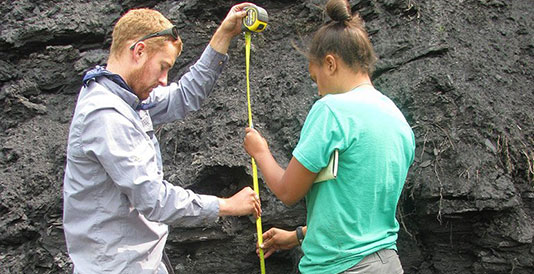 August 1, 2017 (Source: FSU) - There could be some good news on the horizon as scientists try to understand the effects and processes related to climate change. A team of Florida State University scientists has discovered that chemical weathering, a process in which carbon dioxide breaks down rocks and then gets trapped in sediment, can happen at a much faster rate than scientists previously assumed and could potentially counteract some of the current and future climate change caused by humans. The findings were published in the journal Scientific Reports.
August 1, 2017 (Source: FSU) - There could be some good news on the horizon as scientists try to understand the effects and processes related to climate change. A team of Florida State University scientists has discovered that chemical weathering, a process in which carbon dioxide breaks down rocks and then gets trapped in sediment, can happen at a much faster rate than scientists previously assumed and could potentially counteract some of the current and future climate change caused by humans. The findings were published in the journal Scientific Reports.
Scientists have generally thought that this process takes hundreds of thousands to millions of years to occur, helping to alleviate warming trends at an exceptionally slow rate. Rather than potentially millions of years, FSU researchers now suggest it can take several tens of thousands of years. It’s not a quick fix though. “Increased chemical weathering is one of Earth’s natural responses to carbon dioxide increases,” said Theodore Them, the lead researcher on the paper and a postdoctoral researcher at Florida State and the National High Magnetic Field Laboratory. “The good news is that this process can help balance the effects of fossil fuel combustion, deforestation and agricultural practices. The bad news is that it will not begin to counteract the excessive amounts of atmospheric carbon dioxide that humans are emitting for at least several thousand years.”
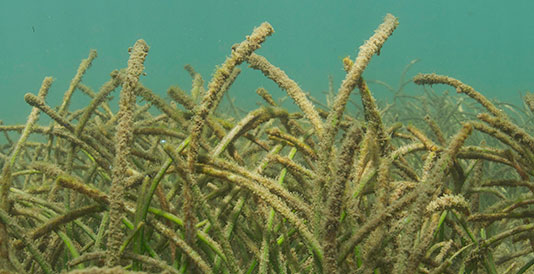 August 7, 2017 (Source: FIU) - Scientists are zeroing in on the seagrass meadows that could help slow down climate change. Seagrass meadows are great absorbers of carbon dioxide from the air. But the algae, animals, corals and plants that live among them release large amounts of carbon dioxide, according to newly released research. The scientists are now identifying seagrass locations with fewer emitters to target for conservation. Scientists at Florida International University examined seagrass meadows in Florida Bay, some of the largest on Earth, where waters are warm and plant and animal abundance is high. They compared these ecosystems to those in southeastern Brazil where meadows are smaller, waters are cooler, and plant and animal abundance is lower. They found that although Florida Bay’s seagrasses act as carbon sinks, the organisms living among them offset the benefits of seagrass carbon storage by releasing carbon dioxide.
August 7, 2017 (Source: FIU) - Scientists are zeroing in on the seagrass meadows that could help slow down climate change. Seagrass meadows are great absorbers of carbon dioxide from the air. But the algae, animals, corals and plants that live among them release large amounts of carbon dioxide, according to newly released research. The scientists are now identifying seagrass locations with fewer emitters to target for conservation. Scientists at Florida International University examined seagrass meadows in Florida Bay, some of the largest on Earth, where waters are warm and plant and animal abundance is high. They compared these ecosystems to those in southeastern Brazil where meadows are smaller, waters are cooler, and plant and animal abundance is lower. They found that although Florida Bay’s seagrasses act as carbon sinks, the organisms living among them offset the benefits of seagrass carbon storage by releasing carbon dioxide.
“In seagrass meadows, these two processes happen simultaneously and have opposite effects on carbon sequestration,” said Jason Howard, researcher in FIU’s Marine Education Research Initiative and lead author of the study. “If we want to mitigate the most carbon dioxide emissions, we need to understand these competing processes and choose conservation sites accordingly.”
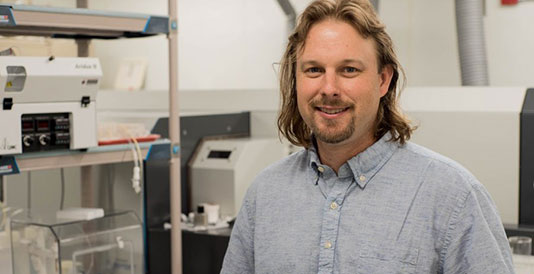 August 9, 2017 (Source: FSU) - A 94-million-year-old climate change event that severely imperiled marine organisms may provide some unnerving insights into long-term trends in our modern oceans, according to a Florida State University researcher.
August 9, 2017 (Source: FSU) - A 94-million-year-old climate change event that severely imperiled marine organisms may provide some unnerving insights into long-term trends in our modern oceans, according to a Florida State University researcher.
In a study published today in the journal Science Advances, Assistant Professor of Geology Jeremy Owens traces a 50,000-year period of ocean deoxygenation preceding an ancient climate event that dramatically disturbed global ocean chemistry and led to the extinction of many marine organisms. He also draws parallels to similar rates of oxygen depletion observed in our contemporary oceans.
“We found that before this major shift in the climate, there was a stretch of oxygen depletion of about 50,000 years,” Owens said. “The rate of deoxygenation during that time is somewhat equivalent to the rate at which many scientists suggest we’re losing oxygen from our oceans today.”
 August 9, 2015 (Source: UF) - Sea level rise hot spots -- bursts of accelerated sea rise that last three to five years -- happen along the U.S. East Coast thanks to a one-two punch from naturally occurring climate variations, a new University of Florida study shows.
August 9, 2015 (Source: UF) - Sea level rise hot spots -- bursts of accelerated sea rise that last three to five years -- happen along the U.S. East Coast thanks to a one-two punch from naturally occurring climate variations, a new University of Florida study shows.
After UF scientists identified a hot spot reaching from Cape Hatteras to Miami, they probed the causes by analyzing tidal and climate data for the U.S. eastern seaboard. The new study, published online today in Geophysical Research Letters, shows that seas rose in the southeastern U.S. between 2011 and 2015 by more than six times the global average sea level rise that is already happening due to human-induced global warming.
The study's findings suggest that future sea level rise resulting from global warming will also have these hot spot periods superimposed on top of steadily rising seas, said study co-author Andrea Dutton, assistant professor in UF's department of geological sciences in the College of Liberal Arts and Sciences.
"The important point here is that smooth projections of sea level rise do not capture this variability, so adverse effects of sea level rise may occur before they are predicted to happen," Dutton said. "The entire U.S. Atlantic coastline is vulnerable to these hot spots that may amplify the severity of coastal flooding."
UF News Release
August 11, 2017 (Source: FL DEP) - The Florida Department of Environmental Protection, in partnership with the U.S. Coast Guard (USCG) and Nova Southeastern University (NSU), has modified the Port of Miami Anchorage Area in Miami Beach. Changes in design and configuration will protect more than 600 acres of coral reef from future impacts by keeping boats from protected reef areas. The anchorage area, where boats can safely maneuver and park, will now be divided into two separate areas, including an inner western anchorage for smaller vessels and an outer eastern anchorage for larger vessels totaling 1.5 square nautical miles.
"This outstanding conservation management achievement is a testament to how local stakeholders can effectively work together to protect Florida's ecologically and economically important coral reefs," said Joanna Walczak, Southeast regional administrator for DEP's Florida Coastal Office.
The new anchorages are the result of extensive collaboration between numerous stakeholder groups, agencies, universities and private citizens at federal, state and local levels. Studies conducted by DEP and NSU showed that anchorage modification was necessary to reduce reef damage to the ecologically and economically important northern portion of the Florida Reef Tract. This study led to the formation of a working group coordinated by USCG, DEP and NSU, where a group of varied stakeholders including federal and state agencies, port pilots, Port Miami administration, university scientists and other shipping interests worked together to design the new configuration.
FIU Marine Ecologist James Fourqurean Elected President of Coastal and Estuarine Research Federation
 August 15, 2017 (Source: FIU) - FIU marine ecologist James Fourqurean has been elected president of the Coastal and Estuarine Research Federation. Fourqurean will lead the organization, which is comprised of people who study and manage estuaries, with a plan to educate public officials about coastal science and resilience in a changing climate.
August 15, 2017 (Source: FIU) - FIU marine ecologist James Fourqurean has been elected president of the Coastal and Estuarine Research Federation. Fourqurean will lead the organization, which is comprised of people who study and manage estuaries, with a plan to educate public officials about coastal science and resilience in a changing climate.
“Distrust of scientists seems to be at an all-time high when scientific understanding is really important to help us face the coming challenges of a changing environment,” said Fourqurean, director of FIU’s Marine Education and Research Initiative. “I hope to ease the dialog between elected officials and scientists so we can share ideas to ensure a better future.”
August 17, 2017 (Source: UM/RSMAS) - Predicting the weather three to four weeks in advance is extremely challenging, yet many critical decisions affecting communities and economies must be made using this lead time. However, model forecasts available for the first time this week could help NOAA’s operational Climate Prediction Center (CPC) significantly improve its week 3-4 temperature and precipitation outlooks for the U.S.
The Subseasonal Experiment (SubX) is a two year project, led by University of Miami (UM) Rosenstiel School of Marine and Atmospheric Science atmospheric scientist Ben Kirtman, that combines multiple global models from NOAA, NASA, Environment Canada, the Navy, and National Center for Atmospheric Research to produce once-a-week real-time experimental forecasts as well as a set of forecasts for past dates, called reforecasts, now available to both CPC and the research community.
“The multi-model reforecasts perfectly dovetail with the real-time forecasts so that you can perform a robust calibration and skill assessment,” said Ben Kirtman, lead of the SubX project team and University of Miami Rosenstiel School atmospheric scientist. “The research you do can immediately translate into potential improvements of an operational product, and that’s really exciting.”
August 30, 2017 - Joseph Smoak (USF), Brad Rosenheim (USF College of Marine Science), Ryan Moyer and Kara Radabaugh (Florida Fish & Wildlife Research Institute), Lisa Chambers (University of Central Florida), and David Lagomasino (University of Maryland) have been award a $1.33 million grant from the United States Department of Agriculture to study “Blue Carbon” ecosystems along the South Florida coast. Blue Carbon is a term used to describe carbon captured in the ocean and coastal ecosystems. The goal of the project is to measure and map carbon stored in the coastal wetlands of South Florida and predict how these stores of carbon will change under the influence of climate change and anthropogenic pressures. The collection of the data involves field sampling in the wetlands, the use of NASA fixed wing aircraft and satellite imagery.
Grant title: Organic carbon biomass, burial, and biogeochemistry in blue carbon ecosystems along the South Florida coast: climate change and anthropogenic influences
September 11, 2017 (Source: University of Bonn) - The East Coast of the United States is threatened by more frequent flooding in the future. This is shown by a recent study by the Universities of Bonn, South Florida, and Rhode Island. According to this, the states of Virginia, North Carolina, and South Carolina are most at risk. Their coastal regions are being immersed by up to three millimeters per year – among other things, due to human intervention. The work is published in the journal Scientific Reports by the Nature Publishing Group.
Cities such as Miami on the East Coast of the USA are being affected by flooding more and more frequently. The causes are often not hurricanes with devastating rainfall such as Katrina, or the recent hurricanes Harvey or Irma. On the contrary: flooding even occurs on sunny, relatively calm days. It causes damage to houses and roads and disrupts traffic, yet does not cost any people their lives. It is thus also known as ‘nuisance flooding’.
And this nuisance is set to occur much more frequently in the future. At least researchers from the Universities of Bonn, South Florida, and Rhode Island are convinced of this. The international team evaluated data from the East Coast of America, including GPS and satellite measurements. These show that large parts of the coastal region are slowly yet steadily sinking into the Atlantic Ocean.
“There are primarily two reasons for this phenomenon,” explains Makan A. Karegar from the University of South Florida, currently a guest researcher at the Institute of Geodesy and Geoinformation at the University of Bonn. “During the last ice age around 20,000 years ago, large parts of Canada were covered by an ice sheet. This tremendous mass pressed down on the continent.” Some areas of the earth’s mantle were thus pressed sideways under the ice, causing the coastal regions that were free of ice to be raised. “When the ice sheet then melted, this process was reversed,” explains Karegar. “The East Coast has thus been sinking back down for the last few thousand years.”

September 21, 2017 (Source: FIU) - A team of researchers headed by FIU College of Business professor Shahid Hamid, using the Florida Public Hurricane Loss Model, estimates that Hurricane Irma caused $19.4 billion in wind-related losses to Florida residents alone. The data doesn’t cover flood losses.
Of that total, $6.3 billion will be paid by insurance companies. As a result, roughly two-thirds of the losses will be borne by homeowners. The highest wind losses are in Lee County (Fort Myers and Cape Coral), followed by Collier County (Naples, Marco Island and Immokalee).
Hamid’s team includes specialists in meteorology, storm surge, hydrology, engineering, finance and actuarial science, computer science and statistics from FIU as well as the University of Florida, Florida State University, Florida Institute of Technology, University of Miami and the National Oceanic and Atmospheric Administration
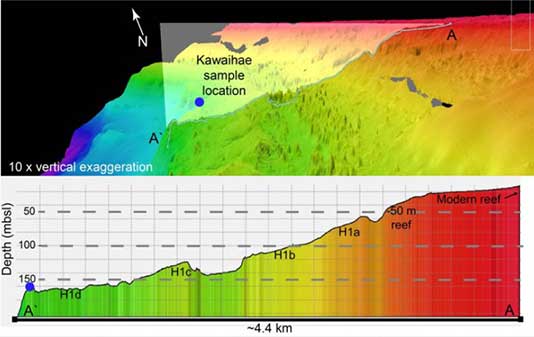
September 28, 2017 (Source: University of Sydney/Science Daily) - Investigations to predict changes in sea levels and their impacts on coastal systems are a step closer, as a result of international collaboration between the University of Sydney and researchers from Japan, Spain, and the United States.
Scientists globally are investigating just how quickly sea-level rise can occur as a result of global warming and ice sheets melting.
Recent findings suggest that episodes of very rapid sea-level rise of about 20m in less than 500 years occurred in the last deglaciation, caused by periods of catastrophic ice-sheet collapse as Earth warmed after the last ice age about 20,000 years ago.
Lead author, PhD candidate at the University of Sydney, Kelsey Sanborn, has shown this sea-level rise event was associated with "drowning" or death of coral reefs in Hawaii.
The research was a collaborative effort between the University of Sydney, the University of Tokyo, the University of Florida, the University of Granada, the Monterey Bay Aquarium Research Institute, the University of Hawaii, and the Association for Marine Exploration.
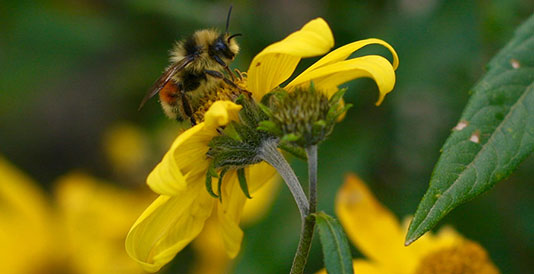 September 29, 2017 (Source: FSU) - New research from a team of Florida State University scientists and their collaborators is helping to explain the link between a changing global climate and a dramatic decline in bumble bee populations worldwide.
September 29, 2017 (Source: FSU) - New research from a team of Florida State University scientists and their collaborators is helping to explain the link between a changing global climate and a dramatic decline in bumble bee populations worldwide.
In a study published Friday, Sept. 29, in the journal Ecology Letters, researchers examining three subalpine bumble bee species in Colorado’s Rocky Mountains found that, for some bumble bees, a changing climate means there just aren’t enough good flowers to go around.
The team analyzed the bees’ responses to direct and indirect climate change effects.
“Knowing whether climate variation most affects bumble bees directly or indirectly will allow us to better predict how bumble bee populations will cope with continued climate change,” said FSU postdoctoral researcher Jane Ogilvie, the study’s lead investigator. “We found that the abundances of all three bumble bee species were mostly affected by indirect effects of climate on flower distribution through a season.”
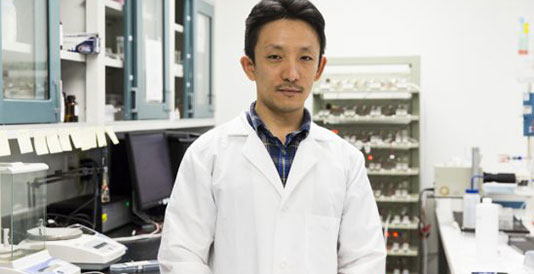 October 2, 2017 (Source: UCF) - It’s possible to produce hydrogen to power fuel cells by extracting the gas from seawater, but the electricity required to do it makes the process costly. UCF researcher Yang Yang has come up with a new hybrid nanomaterial that harnesses solar energy and uses it to generate hydrogen from seawater more cheaply and efficiently than current materials. The breakthrough could someday lead to a new source of the clean-burning fuel, ease demand for fossil fuels and boost the economy of Florida, where sunshine and seawater are abundant.
October 2, 2017 (Source: UCF) - It’s possible to produce hydrogen to power fuel cells by extracting the gas from seawater, but the electricity required to do it makes the process costly. UCF researcher Yang Yang has come up with a new hybrid nanomaterial that harnesses solar energy and uses it to generate hydrogen from seawater more cheaply and efficiently than current materials. The breakthrough could someday lead to a new source of the clean-burning fuel, ease demand for fossil fuels and boost the economy of Florida, where sunshine and seawater are abundant.
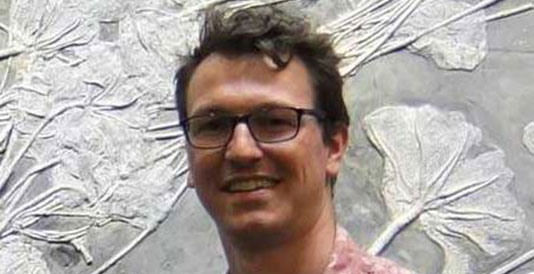 October 10, 2017 (Source: FSU) - Rising levels of carbon dioxide may have little effect on the smallest organisms that live in ocean sediment, according to a new study by a Florida State University researcher. FSU Coastal and Marine Laboratory scientist Jeroen Ingels and a team of researchers found that communities of microscopic organisms called meiofauna don’t change much when faced with both rising carbon dioxide levels and higher temperatures. That’s in contrast to larger organisms, which have previously shown to be largely affected by changes in environment. Meiofauna are miniscule invertebrates that live in both marine and fresh water environments. They are the base of the food web, so researchers are eager to learn more about how climate change may affect them.
October 10, 2017 (Source: FSU) - Rising levels of carbon dioxide may have little effect on the smallest organisms that live in ocean sediment, according to a new study by a Florida State University researcher. FSU Coastal and Marine Laboratory scientist Jeroen Ingels and a team of researchers found that communities of microscopic organisms called meiofauna don’t change much when faced with both rising carbon dioxide levels and higher temperatures. That’s in contrast to larger organisms, which have previously shown to be largely affected by changes in environment. Meiofauna are miniscule invertebrates that live in both marine and fresh water environments. They are the base of the food web, so researchers are eager to learn more about how climate change may affect them.
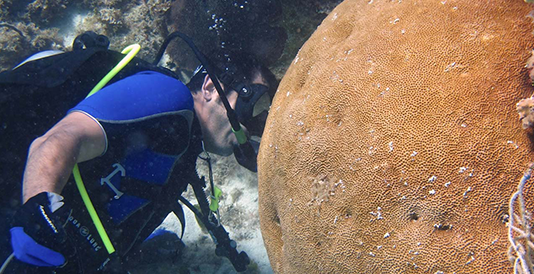 October 2017 (Source: UM) - Andrew C. Baker (UM) is big on the study of the ecology and conservation of coral reefs, with particular attention to the impact of climate change on these fragile environments. Corals in Cuba, considered to be some of most pristine in the Caribbean, may help determine how these ecosystems can survive climate change.
October 2017 (Source: UM) - Andrew C. Baker (UM) is big on the study of the ecology and conservation of coral reefs, with particular attention to the impact of climate change on these fragile environments. Corals in Cuba, considered to be some of most pristine in the Caribbean, may help determine how these ecosystems can survive climate change.
 Florida’s Climate: Changes, Variations, & Impacts
Florida’s Climate: Changes, Variations, & Impacts
Edited by Eric P. Chassignet, James W. Jones, Vasubandhu Misra, & Jayantha Obeysekera
Paperback: 632 pages
Publisher: Florida Climate Institute
Printed By: CreateSpace Independent Publishing Platform
Publication Date: November 29, 2017
ISBN-10: 1979091048
ISBN-13: 978-1979091046
Product Dimensions: 7 x 1.4 x 10 inches
Citation: Chassignet, E. P., Jones, J. W., Misra, V., & Obeysekera, J. (Eds.). (2017). Florida's climate: Changes, variations, & impacts. Gainesville, FL: Florida Climate Institute. https://doi.org/10.17125/fci2017
Description:
Florida’s climate has been and continues to be one of its most important assets. It has enabled the growth of many major industries, including tourism and agriculture, which now rank at the top of Florida’s diverse economic activities. Our state’s climate enables its native ecosystems to flourish and attract citizens from around the world. The dependencies of Florida’s society and ecosystems on climate are widely recognized and generally taken for granted. However, we now know that climate around the world is changing. Questions arise about whether or not Florida’s climate is changing, how rapidly these changes might occur, and how Florida may adapt to anticipated changes and help mitigate the rates of change.
This book provides a thorough review of the current state of research on Florida's climate, including physical climate benchmarks; climate prediction, projection, and attribution; and the impacts of climate and climate change on the people and natural resources of Florida. The editors have gathered more than 90 researchers at universities across the state and beyond to address important topics such as sea level rise, water resources, and how climate affects various sectors, including energy, agriculture, forestry, tourism, and insurance. This volume offers accessible, accurate information for students, policymakers, and the general public.
About the Editors:
Eric P. Chassignet is a professor in the Department of Earth, Ocean and Atmospheric Science and director of the Center for Ocean-Atmospheric Prediction Studies at Florida State University. James W. Jones is a distinguished professor emeritus in the Department of Agricultural and Biological Engineering at the University of Florida. Vasubandhu Misra is an associate professor in the Department of Earth, Ocean and Atmospheric Science and the Center for Ocean-Atmospheric Prediction Studies at Florida State University. Jayantha Obeysekera is the chief modeler at the South Florida Water Management District.
Download Book Summary and Key Messages
Contents
Terms and Conditions: Readers may view, browse, and/or download material for temporary copying purposes only, provided these uses are for noncommercial personal purposes. Except as provided by law, this material may not be further reproduced, distributed, transmitted, modified, adapted, performed, displayed, published, or sold in whole or in part, without prior written permission from the Florida Climate Institute.
PDFs of individual chapters are available for download below:
Executive Summary
Eric P. Chassignet, James W. Jones, Vasubandhu Misra, and Jayantha Obeysekera
Citation: Chassignet, E. P., Jones, J. W., Misra, V., & Obeysekera, J. (2017). Executive summary. In E. P. Chassignet, J. W. Jones, V. Misra, & J. Obeysekera (Eds.), Florida's climate: Changes, variations, & impacts (iii-viii). Gainesville, FL: Florida Climate Institute. https://doi.org/10.17125/fci2017.exsum
Societal Challenges Associated with Climate and Climate Change in Florida
1. Human Dimensions and Communication of Florida's Climate
Peter J. Jacques, Kenneth Broad, William Butler, Christopher Emrich, Sebastian Galindo, Claire Knox, Keith W. Rizzardi, and Kathryn Ziewitz
Citation: Jacques, P. J., Broad, K., Butler, W., Emrich, C., Galindo, S., Knox, C., et al. (2017). Human dimensions and communication of Florida's climate. In E. P. Chassignet, J. W. Jones, V. Misra, & J. Obeysekera (Eds.), Florida's climate: Changes, variations, & impacts (pp. 1–50). Gainesville, FL: Florida Climate Institute. https://doi.org/10.17125/fci2017.ch01
2. Florida Land Use and Land Cover Change in the Past 100 Years
Michael I. Volk, Thomas S. Hoctor, Belinda B. Nettles, Richard Hilsenbeck, Francis E. Putz, and Jon Oetting
Citation: Volk, M. I., Hoctor, T. S., Nettles, B. B., Hilsenbeck, R., Putz, F. E., & Oetting, J. (2017). Florida land use and land cover change in the past 100 years. In E. P. Chassignet, J. W. Jones, V. Misra, & J. Obeysekera (Eds.), Florida's climate: Changes, variations, & impacts (pp. 51–82). Gainesville, FL: Florida Climate Institute. https://doi.org/10.17125/fci2017.ch02
3. Implications of Climate Change on Florida's Water Resources
Jayantha Obeysekera, Wendy Graham, Michael C. Sukop, Tirusew Asefa, Dingbao Wang, Kebreab Ghebremichael, and Benjamin Mwashote
Citation: Obeysekera, J., Graham, W., Sukop, M. C., Asefa, T., Wang, D., Ghebremichael, K., et al. (2017). Implications of climate change on Florida's water resources. In E. P. Chassignet, J. W. Jones, V. Misra, & J. Obeysekera (Eds.), Florida's climate: Changes, variations, & impacts (pp. 83–124). Gainesville, FL: Florida Climate Institute. https://doi.org/10.17125/fci2017.ch03
4. Climate Change Impacts on Human Health
Song Liang, Kristina Kintziger, Phyllis Reaves, and Sadie Ryan
Citation: Liang, S., Kintziger, K., Reaves, P., & Ryan, S. J. (2017). Climate change impacts on human health. In E. P. Chassignet, J. W. Jones, V. Misra, & J. Obeysekera (Eds.), Florida's climate: Changes, variations, & impacts (pp. 125–152). Gainesville, FL: Florida Climate Institute. https://doi.org/10.17125/fci2017.ch04
5. Climate Change Impacts on Florida's Energy Supply and Demand
Wendell A. Porter and Hal Knowles III
Citation: Porter, W. A., & Knowles III, H. (2017). Climate change impacts on Florida's energy supply and demand. In E. P. Chassignet, J. W. Jones, V. Misra, & J. Obeysekera (Eds.), Florida's climate: Changes, variations, & impacts (pp. 153–177). Gainesville, FL: Florida Climate Institute. https://doi.org/10.17125/fci2017.ch05
6. Climate Change Impacts on Insurance in Florida
Lorilee Medders
Citation: Medders, L. (2017). Climate change impacts on insurance in Florida. In E. P. Chassignet, J. W. Jones, V. Misra, & J. Obeysekera (Eds.), Florida's climate: Changes, variations, & impacts (pp. 179–207). Gainesville, FL: Florida Climate Institute. https://doi.org/10.17125/fci2017.ch06
7. Climate Change Impacts on Law and Policy in Florida
Thomas Ruppert and Erin L. Deady
Citation: Ruppert, T., & Deady, E. L. (2017). Climate change impacts on law and policy in Florida. In E. P. Chassignet, J. W. Jones, V. Misra, & J. Obeysekera (Eds.), Florida's climate: Changes, variations, & impacts (pp. 209–234). Gainesville, FL: Florida Climate Institute. https://doi.org/10.17125/fci2017.ch07
Economic and Environmental Challenges Associated with Climate Change in Florida
8. Climate Change Impacts and Adaptation in Florida's Agriculture
Young Gu Her, Kenneth J. Boote, Kati W. Migliaccio, Clyde Fraisse, David Letson, Odemari Mbuya, Aavudai Anandhi, Hongmei Chi, Lucy Ngatia, and Senthold Asseng
Citation: Her, Y. G., Boote, K. J., Migliaccio, K. W., Fraisse, C., Letson, D., Mbuya, O., et al. (2017). Climate change impacts and adaptation in Florida's agriculture. In E. P. Chassignet, J. W. Jones, V. Misra, & J. Obeysekera (Eds.), Florida's climate: Changes, variations, & impacts (pp. 235–267). Gainesville, FL: Florida Climate Institute. https://doi.org/10.17125/fci2017.ch08
9. Managing Florida's Plantation Forests in a Changing World
Timothy A. Martin, Damian C. Adams, Matthew J. Cohen, Raelene M. Crandall, Carlos A. Gonzalez-Benecke, Jason A. Smith, and Jason G. Vogel
Citation: Martin, T. A., Adams, D. C., Cohen, M. J., Crandall, R. M., Gonzalez-Benecke, C. A., Smith, J. A., et al. (2017). Managing Florida's plantation forests in a changing climate. In E. P. Chassignet, J. W. Jones, V. Misra, & J. Obeysekera (Eds.), Florida's climate: Changes, variations, & impacts (pp. 269–295). Gainesville, FL: Florida Climate Institute. https://doi.org/10.17125/fci2017.ch09
10. Florida Tourism
Julie Harrington, Hongmei Chi, and Lori Pennington Gray
Citation: Harrington, J., Chi, H., & Gray, L. P. (2017). Florida tourism. In E. P. Chassignet, J. W. Jones, V. Misra, & J. Obeysekera (Eds.), Florida's climate: Changes, variations, & impacts (pp. 297–309). Gainesville, FL: Florida Climate Institute. https://doi.org/10.17125/fci2017.ch10
11. Adaptation of Florida's Urban Infrastructure to Climate Change
Frederick Bloetscher, Serena Hoermann, and Leonard Berry
Citation: Bloetscher, F., Hoermann, S., & Berry, L. (2017). Adaptation of Florida's urban infrastructure to climate change. In E. P. Chassignet, J. W. Jones, V. Misra, & J. Obeysekera (Eds.), Florida's climate: Changes, variations, & impacts (pp. 311–338). Gainesville, FL: Florida Climate Institute. https://doi.org/10.17125/fci2017.ch11
12. Climate Change Impacts on Florida's Biodiversity and Ecology
Beth Stys, Tammy Foster, Mariana M.P.B. Fuentes, Bob Glazer, Kimberly Karish, Natalie Montero, and Joshua S. Reece
Citation: Stys, B., Foster, T., Fuentes, M. M. P. B., Glazer, B., Karish, K., Montero, N., et al. (2017). Climate change impacts on Florida's biodiversity and ecology. In E. P. Chassignet, J. W. Jones, V. Misra, & J. Obeysekera (Eds.), Florida's climate: Changes, variations, & impacts (pp. 339–389). Florida Climate Institute. https://doi.org/10.17125/fci2017.ch12
13. Florida's Oceans and Marine Habitats in a Changing Climate
Steven Morey, Marguerite Koch, Yanyun Liu, and Sang-Ki Lee
Citation: Morey, S., Koch, M., Liu, Y., & Lee, S. - K. (2017). Florida's oceans and marine habitats in a changing climate. In E. P. Chassignet, J. W. Jones, V. Misra, & J. Obeysekera (Eds.), Florida's climate: Changes, variations, & impacts (pp. 391–425). Gainesville, FL: Florida Climate Institute. https://doi.org/10.17125/fci2017.ch13
14. Climate Change Impacts on Florida's Fisheries and Aquaculture Sectors and Options for Mitigation
Kai Lorenzen, Cameron Ainsworth, Shirley Baker, Luiz Barbieri, Edward Camp, Jason Dotson, and Sarah Lester
Citation: Lorenzen, K., Ainsworth, C. H., Baker, S. M., Barbieri, L. R., Camp, E. V., Dotson, J. R., et al. (2017). Climate change impacts on Florida's fisheries and aquaculture sectors and options for adaptation. In E. P. Chassignet, J. W. Jones, V. Misra, & J. Obeysekera (Eds.), Florida's climate: Changes, variations, & impacts (pp. 427–455). Gainesville, FL: Florida Climate Institute. https://doi.org/10.17125/fci2017.ch14
Florida's Physical Climate: Past, Present, and Future
15. Paleoclimate of Florida
Albert C. Hine, Ellen E. Martin, John M. Jaeger, and Mark Brenner
Citation: Hine, A. C., Martin, E. E., Jaeger, J. M., & Brenner, M. (2017). Paleoclimate of Florida. In E. P. Chassignet, J. W. Jones, V. Misra, & J. Obeysekera (Eds.), Florida's climate: Changes, variations, & impacts (pp. 457–484). Gainesville, FL: Florida Climate Institute. https://doi.org/10.17125/fci2017.ch15
16. Terrestrial and Ocean Climate of the 20th Century
Vasubandhu Misra, Christopher Selman, Amanda J. Waite, Satish Bastola, and Akhilesh Mishra
Citation: Misra, V., Selman, C., Waite, A. J., Bastola, S., & Mishra, A. (2017). Terrestrial and ocean climate of the 20th century. In E. P. Chassignet, J. W. Jones, V. Misra, & J. Obeysekera (Eds.), Florida's climate: Changes, variations, & impacts (pp. 485–509). Gainesville, FL: Florida Climate Institute. https://doi.org/10.17125/fci2017.ch16
17. Florida Climate Variability and Prediction
Ben P. Kirtman, Vasubandhu Misra, Robert J. Burgman, Johnna Infanti, and Jayantha Obeysekera
Citation: Kirtman, B. P., Misra, V., Burgman, R. J., Infanti, J., & Obeysekera, J. (2017). Florida climate variability and prediction. In E. P. Chassignet, J. W. Jones, V. Misra, & J. Obeysekera (Eds.), Florida's climate: Changes, variations, & impacts (pp. 511–532). Gainesville, FL: Florida Climate Institute. https://doi.org/10.17125/fci2017.ch17
18. Future Climate Change Scenarios for Florida
Ben P. Kirtman, Vasubandhu Misra, Aavudai Anandhi, Diane Palko, and Johnna Infanti
Citation: Kirtman, B. P., Misra, V., Anandhi, A., Palko, D., & Infanti, J. (2017). Future climate change scenarios for Florida. In E. P. Chassignet, J. W. Jones, V. Misra, & J. Obeysekera (Eds.), Florida's climate: Changes, variations, & impacts (pp. 533–555). Gainesville, FL: Florida Climate Institute. https://doi.org/10.17125/fci2017.ch18
19. Sea Level Rise
Gary Mitchum, Andrea Dutton, Don P. Chambers, and Shimon Wdowinski
Citation: Mitchum, G., Dutton, A., Chambers, D. P., & Wdowinski, S. (2017). Sea level rise. In E. P. Chassignet, J. W. Jones, V. Misra, & J. Obeysekera (Eds.), Florida's climate: Changes, variations, & impacts (pp. 557–578). Gainesville, FL: Florida Climate Institute. https://doi.org/10.17125/fci2017.ch19
20. Climate and Weather Extremes
Jennifer M. Collins, Charles H Paxton, Thomas Wahl, and Christopher T. Emrich
Citation: Collins, J. M., Paxton, C. H., Wahl, T., & Emrich, C. T. (2017). Climate and weather extremes. In E. P. Chassignet, J. W. Jones, V. Misra, & J. Obeysekera (Eds.), Florida's climate: Changes, variations, & impacts (pp. 579–615). Gainesville, FL: Florida Climate Institute. https://doi.org/10.17125/fci2017.ch20
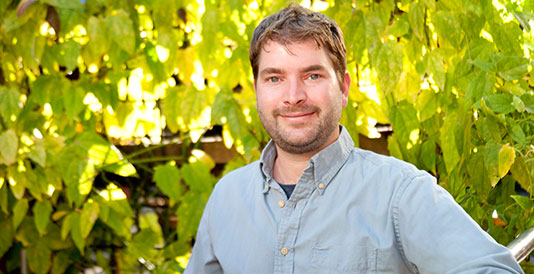 November 8, 2017 - For once in our field, breaking records was a good thing. At least that is the case for one soon to be graduate student. After eight semesters of the maximum course-load, the effort has afforded Russell Anderson the highest number of graduate certificates obtained at both the University and State University System of Florida levels.
November 8, 2017 - For once in our field, breaking records was a good thing. At least that is the case for one soon to be graduate student. After eight semesters of the maximum course-load, the effort has afforded Russell Anderson the highest number of graduate certificates obtained at both the University and State University System of Florida levels.
We interviewed Russell to get some insights into his accomplishments. He returned to pursue advanced education after leaving the professional organizing world in search of ‘bigger pictures and greater truths’. Now, he is leaving the University of Florida with a Masters in Sustainable Development Practice, a concentration in Climate Science and six graduate certificates (from four UF colleges) that include: Latin American Studies, Tropical Conservation and Development, Emergency Services - Disaster Preparedness, Agriculture Education Leadership, Natural Resource Policy Administration, and Ecological Restoration; In addition to performing extensive fieldwork across Belize and Florida coastal (terrestrial and marine) environments.
“My reasoning for sharing this personal accolade was not to brag or boast. Furthermore, I encourage those that may read this, to avoid such endeavors, if you value time, money and sanity. I wanted to share my story to encourage us all to think BIG, capitalize on your networks, and realize the (rapidly approaching) implications of today’s actions on tomorrow’s world. We all have a role in building solutions to our future challenges.“
“It has always been a knack of mine to find the webs of significance and limitations of our respective silos of experiences. Ultimately, that is what drove my desire to understand the natural world, society, and our collective realities to come.” It is only fitting that his next steps include the launch of a transnational sustainable development consortium, focused on impact planning for 2050. ‘We are currently in the process of transferring materials into 14 languages across 22 nations and planning on launching in January 2018,” said Russell.
“During my time at the University of Florida, it has been my privilege to learn from some of the most dynamic and informed educators in the country. The climate science concentration, under the direction of Carolyn Cox of the Florida Climate Institute, was instrumental in my success. I encourage my peers and colleagues to check out the Climate Science Concentration and some of the many graduate programs available.”
“It is a big and complex world out there and it’s only going to get weirder… The more we know the better off we are. More importantly, we are all in this together! So, don’t forget to look beyond your silos and keep your networks strong. When it comes down to it, our communities and experiences are the best resources we have to foster a better tomorrow.”
Have questions or want to connect? Contact Russell at Linkedin.com/in/russ-2050/
 November 9, 2017 (Source: FIU) - FIU deployed more than 100 citizen scientists to investigate whether flooding from the most recent King Tide in October was bringing saltwater or freshwater inland to urban areas. The findings could provide critical clues as to why such unusual flooding is occurring in South Florida, what areas are most at-risk and whether the frequency of these floods could be increasing. The community project was organized by the FIU Sea Level Solutions Center in the Institute of Water and Environment along with the School of Communication + Journalism as part of an annual Sea Level Solutions Day at Vizcaya Gardens Garage.
November 9, 2017 (Source: FIU) - FIU deployed more than 100 citizen scientists to investigate whether flooding from the most recent King Tide in October was bringing saltwater or freshwater inland to urban areas. The findings could provide critical clues as to why such unusual flooding is occurring in South Florida, what areas are most at-risk and whether the frequency of these floods could be increasing. The community project was organized by the FIU Sea Level Solutions Center in the Institute of Water and Environment along with the School of Communication + Journalism as part of an annual Sea Level Solutions Day at Vizcaya Gardens Garage.
"We simply could not do this science without citizen engagement, to reach the number of sites we do all at the same time, nor do we have a better opportunity to share the latest science and engage members of our community in sea level solutions," said Tiffany Troxler, director of the FIU Sea Level Solutions Center. “With current technologies, flood modeling projections are not as precise nor accurate as “on-the-ground” measurements that our citizens work together to produce.”
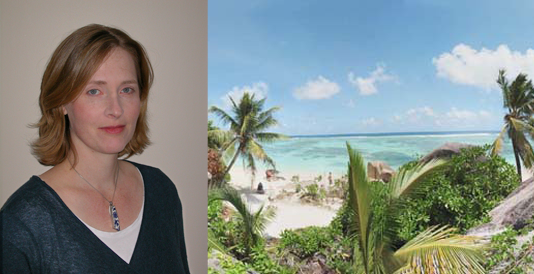 November 17, 2017 - Dr. Andrea Dutton, Assistant Professor of Geology at the University of Florida, has been named one of Rolling Stone Magazine's "25 People Shaping the Future in Tech, Science, Medicine, Activism and More." Dr. Dutton studies sea level reconstruction over glacial-interglacial timescales with an emphasis on establishing the behavior of sea level and ice sheets during interglacial periods to better inform us about future sea-level rise. "I think of myself as a detective," she says. "By understanding what happened in the past, we can get a better understanding of what might happen in the future."
November 17, 2017 - Dr. Andrea Dutton, Assistant Professor of Geology at the University of Florida, has been named one of Rolling Stone Magazine's "25 People Shaping the Future in Tech, Science, Medicine, Activism and More." Dr. Dutton studies sea level reconstruction over glacial-interglacial timescales with an emphasis on establishing the behavior of sea level and ice sheets during interglacial periods to better inform us about future sea-level rise. "I think of myself as a detective," she says. "By understanding what happened in the past, we can get a better understanding of what might happen in the future."

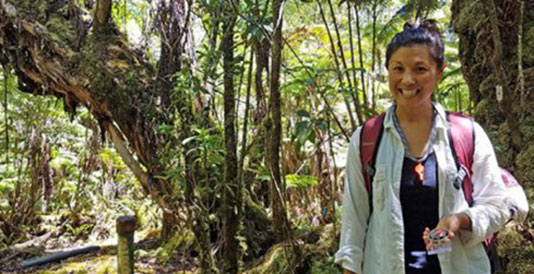 December 7, 2017 (Source: FSU) - Stephanie Pau (FSU) has been awarded a National Geographic grant for her research on tropical forest phenology and climate change by the organization’s Committee for Research and Exploration. Phenology, often referred to as “nature’s calendar,” is the study of periodic plant and animal life cycle events, such as the timing of plant bud bursts or bird migrations, and how these are influenced by seasonal and interannual variations in climate, as well as habitat factors, such as elevation. “Changes in plant phenology have provided some of the best examples of climate change impacts on species and ecosystems,” Pau said. “However, most of this evidence comes from temperate or high-latitude ecosystems. In the tropics, the year-round growing season and the diversity of species exhibiting distinct phenological strategies complicates our understanding of plant phenology.” Pau’s project, “Tropical Forest Phenology in a Changing Climate,” seeks to identify the phenological diversity of plants in two contrasting tropical forest habitats on the island of Hawai‘i, part of a biodiversity hotspot. The proposed research will use monthly field collections of seeds and leaves that fall to the ground, known as litterfall, linked with state-of-the-art satellite observations, which provide repeat wall-to-wall coverage of the Earth’s changing surface.
December 7, 2017 (Source: FSU) - Stephanie Pau (FSU) has been awarded a National Geographic grant for her research on tropical forest phenology and climate change by the organization’s Committee for Research and Exploration. Phenology, often referred to as “nature’s calendar,” is the study of periodic plant and animal life cycle events, such as the timing of plant bud bursts or bird migrations, and how these are influenced by seasonal and interannual variations in climate, as well as habitat factors, such as elevation. “Changes in plant phenology have provided some of the best examples of climate change impacts on species and ecosystems,” Pau said. “However, most of this evidence comes from temperate or high-latitude ecosystems. In the tropics, the year-round growing season and the diversity of species exhibiting distinct phenological strategies complicates our understanding of plant phenology.” Pau’s project, “Tropical Forest Phenology in a Changing Climate,” seeks to identify the phenological diversity of plants in two contrasting tropical forest habitats on the island of Hawai‘i, part of a biodiversity hotspot. The proposed research will use monthly field collections of seeds and leaves that fall to the ground, known as litterfall, linked with state-of-the-art satellite observations, which provide repeat wall-to-wall coverage of the Earth’s changing surface.
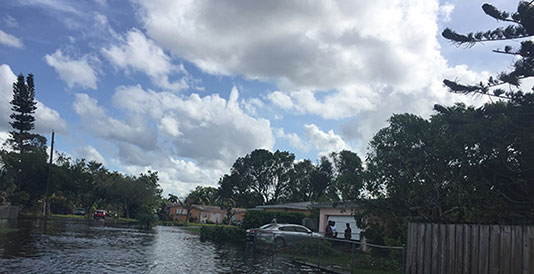 December 13, 2017 (Source: FIU) - South Florida raises groundwater levels to fight salt water intrusion, the threat of flooding from within will only increase, according to FIU research. Current groundwater levels in South Florida are a major contributor to inland flood damages, especially during the wet season or extreme rain events. Traditional flood models account for drainage systems, rivers, streams and canals but do not account for the groundwater beneath our feet. FIU hydrologist Michael Sukop has released a model that focuses on South Florida’s groundwater as a cause of flooding. “Many current flood models treat the land as an impermeable surface when, in fact, South Florida’s land surface is highly permeable and the water table is very close to the surface,” said Sukop, a professor in FIU’s Department of Earth and Environment. “Our model offers a different way of understanding and addressing the flooding problem. When it rains hard enough, or when tides are high, the water table can come all the way to the surface and cause flooding.”
December 13, 2017 (Source: FIU) - South Florida raises groundwater levels to fight salt water intrusion, the threat of flooding from within will only increase, according to FIU research. Current groundwater levels in South Florida are a major contributor to inland flood damages, especially during the wet season or extreme rain events. Traditional flood models account for drainage systems, rivers, streams and canals but do not account for the groundwater beneath our feet. FIU hydrologist Michael Sukop has released a model that focuses on South Florida’s groundwater as a cause of flooding. “Many current flood models treat the land as an impermeable surface when, in fact, South Florida’s land surface is highly permeable and the water table is very close to the surface,” said Sukop, a professor in FIU’s Department of Earth and Environment. “Our model offers a different way of understanding and addressing the flooding problem. When it rains hard enough, or when tides are high, the water table can come all the way to the surface and cause flooding.”
 January 1, 2018 (Source: The Conversation) - Arnoldo Valle-Levinson and Andrea Dutton (UF) have published an article in The Conversation describing an "x-factor" in coast flooding: natural climate patterns that create hot spots of rapid sea level rise. In a study they co-authored with colleague Jon Martin (UF), they showed that two converging natural climate processes created a “hot spot” from Cape Hatteras, North Carolina to Miami where sea levels rose six times faster than the global average between 2011 and 2015. They also showed that such hot spots have occurred at other points along the Eastern Seaboard over the past century. Now they see indications that one is developing in Texas and Louisiana, where it likely amplified flooding during Harvey – and could make future coastal storms more damaging.
January 1, 2018 (Source: The Conversation) - Arnoldo Valle-Levinson and Andrea Dutton (UF) have published an article in The Conversation describing an "x-factor" in coast flooding: natural climate patterns that create hot spots of rapid sea level rise. In a study they co-authored with colleague Jon Martin (UF), they showed that two converging natural climate processes created a “hot spot” from Cape Hatteras, North Carolina to Miami where sea levels rose six times faster than the global average between 2011 and 2015. They also showed that such hot spots have occurred at other points along the Eastern Seaboard over the past century. Now they see indications that one is developing in Texas and Louisiana, where it likely amplified flooding during Harvey – and could make future coastal storms more damaging.
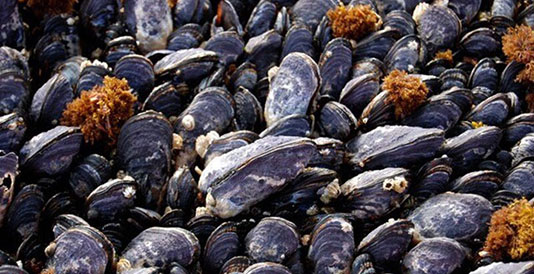 January 5, 2018 (Source: FSU) - Accelerating ocean acidification could be transforming the fundamental structure of California mussel shells, according to a new report from a Florida State University-led team of scientists. For thousands of years, California mussel shells have shared a relatively uniform mineralogical makeup — long, cylindrical calcite crystals ordered in neat vertical rows with crisp, geometric regularity. But in a study published this week in the journal Global Change Biology, researchers suggest that escalating rates of ocean acidification are shaking up that shell mineralogy on its most basic structural levels. “What we’ve seen in more recent shells is that the crystals are small and disoriented,” said Assistant Professor of Biological Science Sophie McCoy, who led the study. “These are significant changes in how these animals produce their shells that can be tied to a shifting ocean chemistry.”
January 5, 2018 (Source: FSU) - Accelerating ocean acidification could be transforming the fundamental structure of California mussel shells, according to a new report from a Florida State University-led team of scientists. For thousands of years, California mussel shells have shared a relatively uniform mineralogical makeup — long, cylindrical calcite crystals ordered in neat vertical rows with crisp, geometric regularity. But in a study published this week in the journal Global Change Biology, researchers suggest that escalating rates of ocean acidification are shaking up that shell mineralogy on its most basic structural levels. “What we’ve seen in more recent shells is that the crystals are small and disoriented,” said Assistant Professor of Biological Science Sophie McCoy, who led the study. “These are significant changes in how these animals produce their shells that can be tied to a shifting ocean chemistry.”
 January 6, 2018 (Source: UF/Bob Graham Center) - Award-winning journalist and author Cynthia Barnett is joining the University of Florida's Bob Graham Center for Public Service as Environmental Fellow in Residence. Barnett is an environmental journalist who has covered water and climate stories worldwide, from the decline in Florida's signature springs, to epic drought in California and Australia, to the rainiest place on Earth in Cherrapunji, India. She is the author of three books on water, including her latest Rain: A Natural and Cultural History, longlisted for the National Book Award, a finalist for the PEN/E.O. Wilson Award for Literary Science writing, winner of the Gold medal in the Florida Book Awards for best general nonfiction and named among the best nonfiction books of 2015 by NPR’s Science Friday, the Boston Globe, the Tampa Bay Times, the Miami Herald and others. Barnett's appointment is shared with UF’s College of Journalism and Communications, where she is Environmental Journalist in Residence and oversees student environmental reporting projects such as award-winning Blue Ether and the recent series Energy Burden. She will continue to teach in CJC and will begin teaching courses for the Graham Center’s public leadership minor. Barnett will also help lead student environmental initiatives and team up across disciplines with UF faculty and students who are working to improve public understanding of complex environmental issues such as climate change.
January 6, 2018 (Source: UF/Bob Graham Center) - Award-winning journalist and author Cynthia Barnett is joining the University of Florida's Bob Graham Center for Public Service as Environmental Fellow in Residence. Barnett is an environmental journalist who has covered water and climate stories worldwide, from the decline in Florida's signature springs, to epic drought in California and Australia, to the rainiest place on Earth in Cherrapunji, India. She is the author of three books on water, including her latest Rain: A Natural and Cultural History, longlisted for the National Book Award, a finalist for the PEN/E.O. Wilson Award for Literary Science writing, winner of the Gold medal in the Florida Book Awards for best general nonfiction and named among the best nonfiction books of 2015 by NPR’s Science Friday, the Boston Globe, the Tampa Bay Times, the Miami Herald and others. Barnett's appointment is shared with UF’s College of Journalism and Communications, where she is Environmental Journalist in Residence and oversees student environmental reporting projects such as award-winning Blue Ether and the recent series Energy Burden. She will continue to teach in CJC and will begin teaching courses for the Graham Center’s public leadership minor. Barnett will also help lead student environmental initiatives and team up across disciplines with UF faculty and students who are working to improve public understanding of complex environmental issues such as climate change.
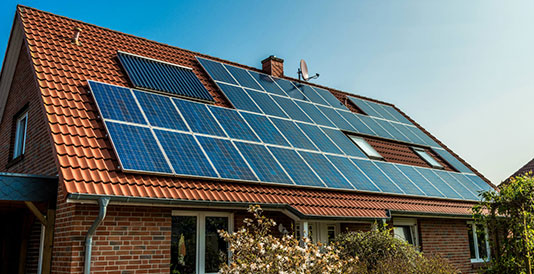 January 8, 2018 (Source: FIU/CASE News) - FIU Department of Biological Sciences professor Philip Stoddard was recently featured in an article by The Center for Public Integrity regarding the effects of climate change on the state of Florida.
January 8, 2018 (Source: FIU/CASE News) - FIU Department of Biological Sciences professor Philip Stoddard was recently featured in an article by The Center for Public Integrity regarding the effects of climate change on the state of Florida.
Philip Stoddard and his wife are saving money to prepare for the day climate problems render their home worthless and force them out. Stoddard lives three miles inland in an area that would be largely submerged — along with much of South Florida — under what the federal government considers a worst-case but worryingly plausible scenario by the end of the century. Some Florida scientists expect even higher sea-level rise. Stoddard is focused on keeping the city livable as long as possible, which means battling a faster-arriving consequence of a warming world.
Stoddard, looking into fixes, sees a need for hard conversations with residents of his city’s lowest-lying neighborhoods. Do they want to pay for expensive upgrades or risk owning homes without working toilets? He sees a future where some communities get ahead of climate problems and others are overwhelmed. Meanwhile, he said, his utility company keeps building gas plants that emit even more of the carbon pollution fueling this slow-motion tragedy.
“It’s going to cost more money, it’s going to pollute the environment — it’s like, why are they doing it?” said Stoddard, a fierce FPL critic. The answer, in his view: “They own natural gas.”
Read the full article for more information on how Florida is affected by climate change.



